This penne with butternut squash and goat cheese is as filling as it is delicious, packed with flavour thanks to a simple homemade pesto, roasted butternut squash and creamy goat cheese.
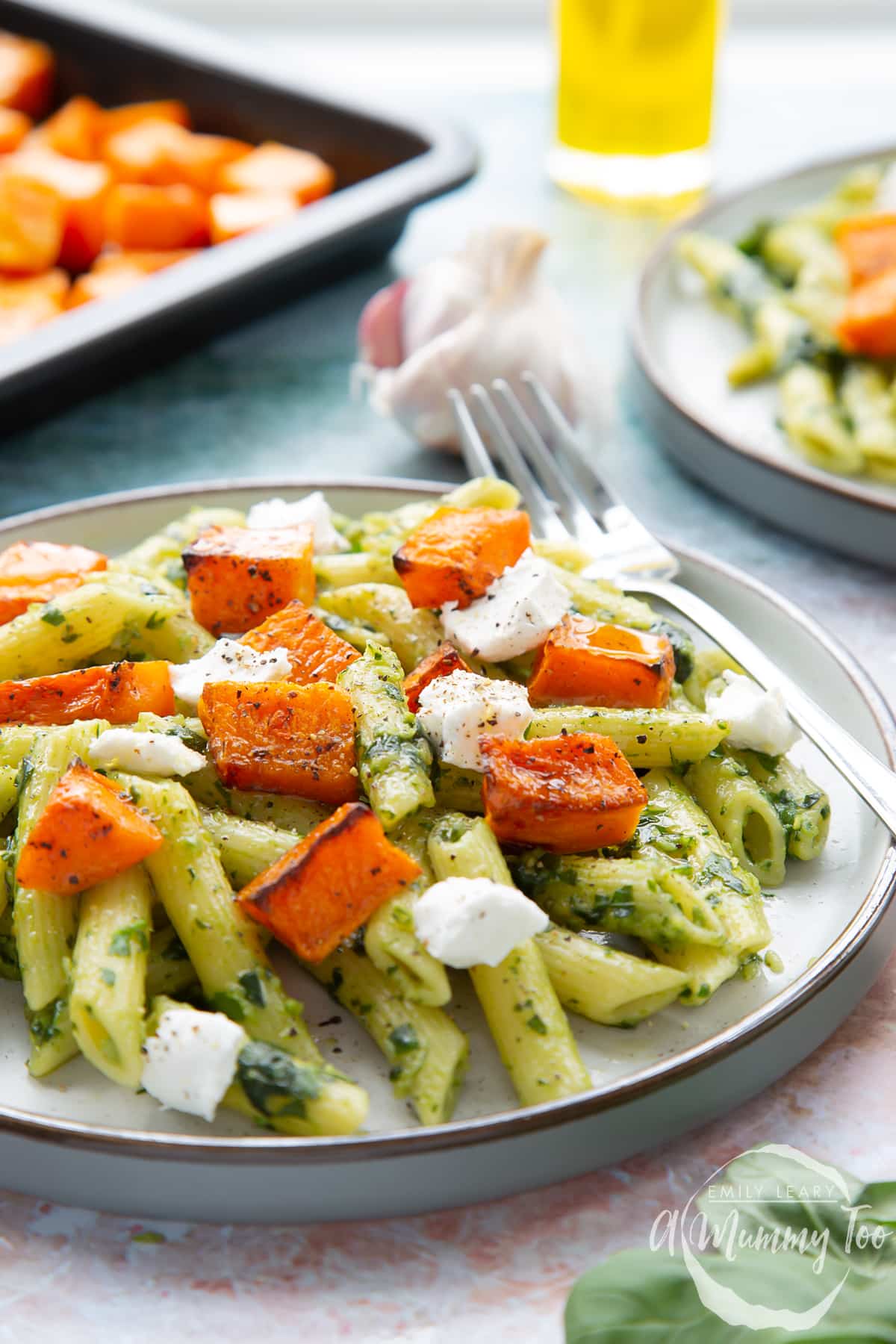
The pesto lends a gorgeously fresh and aromatic flavour to the pasta. It's so worth making from scratch if you - the difference from store bought it incredible!
Meanwhile, roasting the butternut squash brings out so much sweetness and flavour, it's a challenge not to eat it right off the tray as soon as it comes out of the oven.
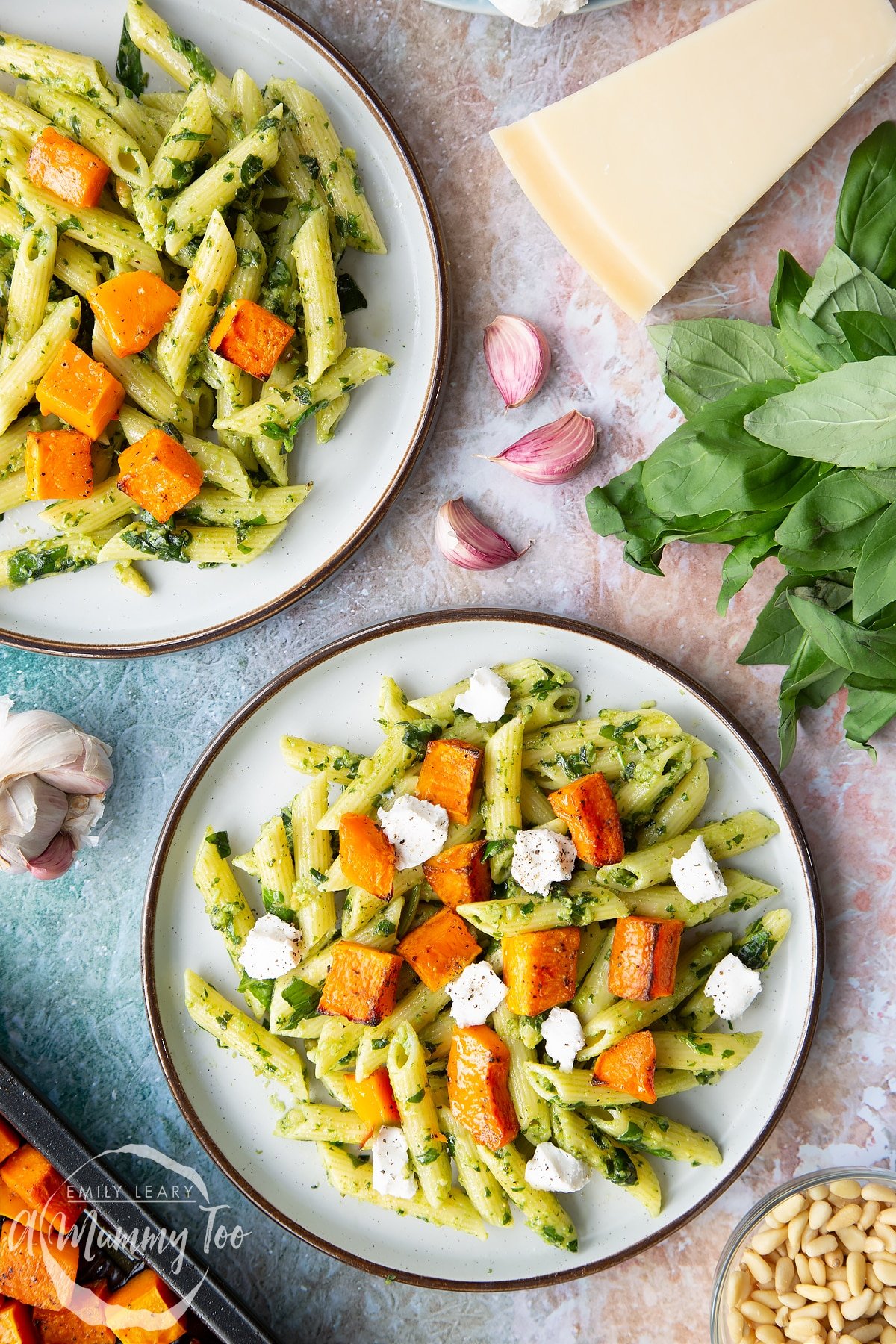
Serving the pasta and squash with goat's cheese really completes the dish, lending a tangy piquancy that perfectly complements the soft, sweet roasted squash and nutty, umami (savoury) pesto.
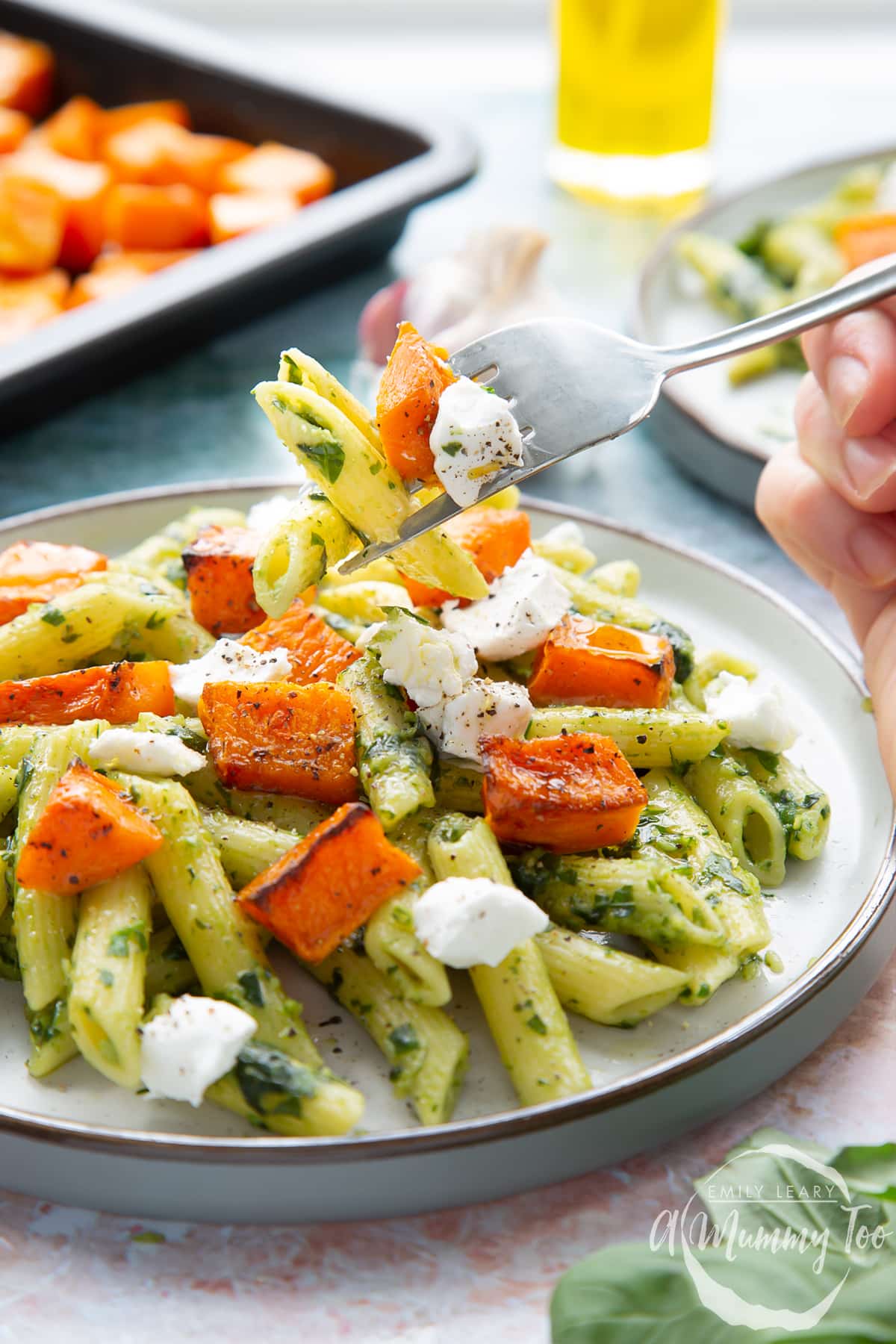
Here's the full recipe. Give it a try.
Ingredients
For the roast butternut squash
- 500 g (1.1 lb) butternut squash flesh cut into 2.5cm (1 inch) pieces
- 2 tbsp olive oil
- pinch salt and black pepper
For the pesto
- 45 g (1.6 oz) pine nuts
- 50 g (1.8 oz) fresh basil
- 2 cloves (2) garlic
- 30 g (1.1 oz) hard cheese Parmesan or vegetarian if required
- 65 ml (2.2 floz) olive oil
- salt and black pepper to taste
For the pasta
- 300 g (10.6 oz) penne pasta
- pinch salt
- 125 g (4.4 oz) goat’s cheese
Equipment
- Medium roasting pan 35x25cm (14x10")
- Food processor or pestle and mortar
Instructions
Make the roasted butternut squash
Preheat the oven to at 220C (200C fan).
Put the butternut squash chunks in a non-stick roasting tray.
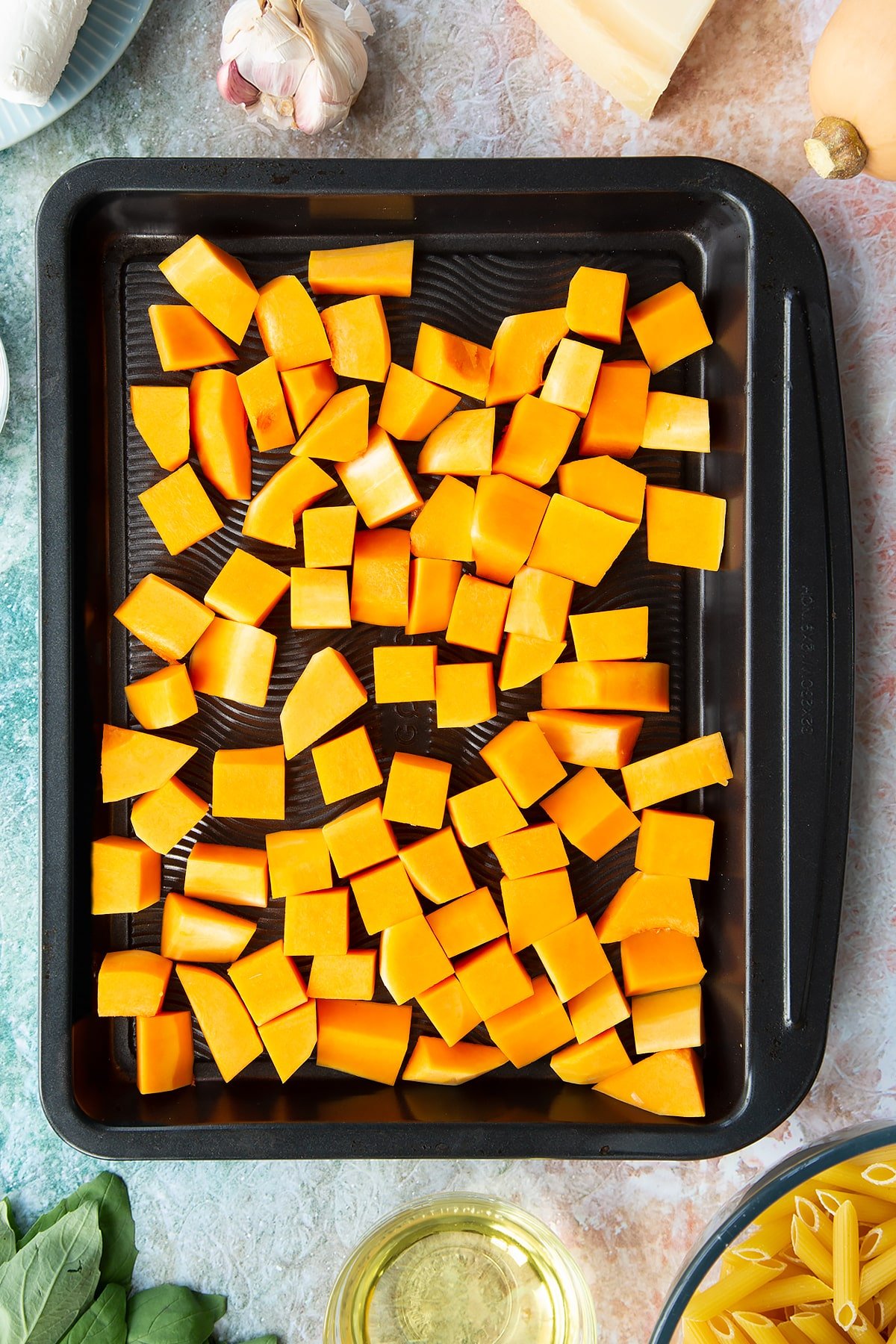
Drizzle with oil and season with salt pepper.
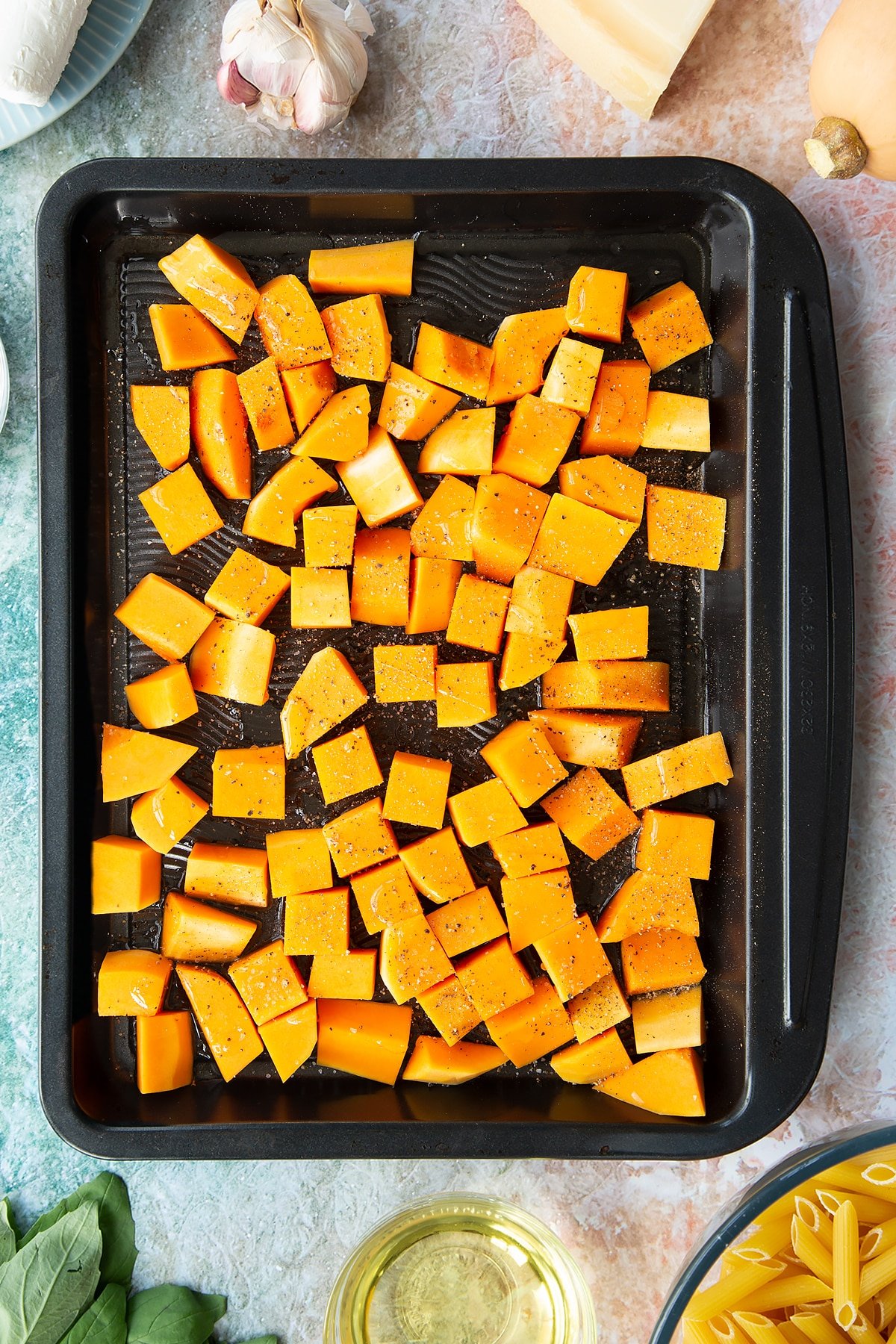
Roast for 20-25 mins until the edges are browned and the insides are soft.
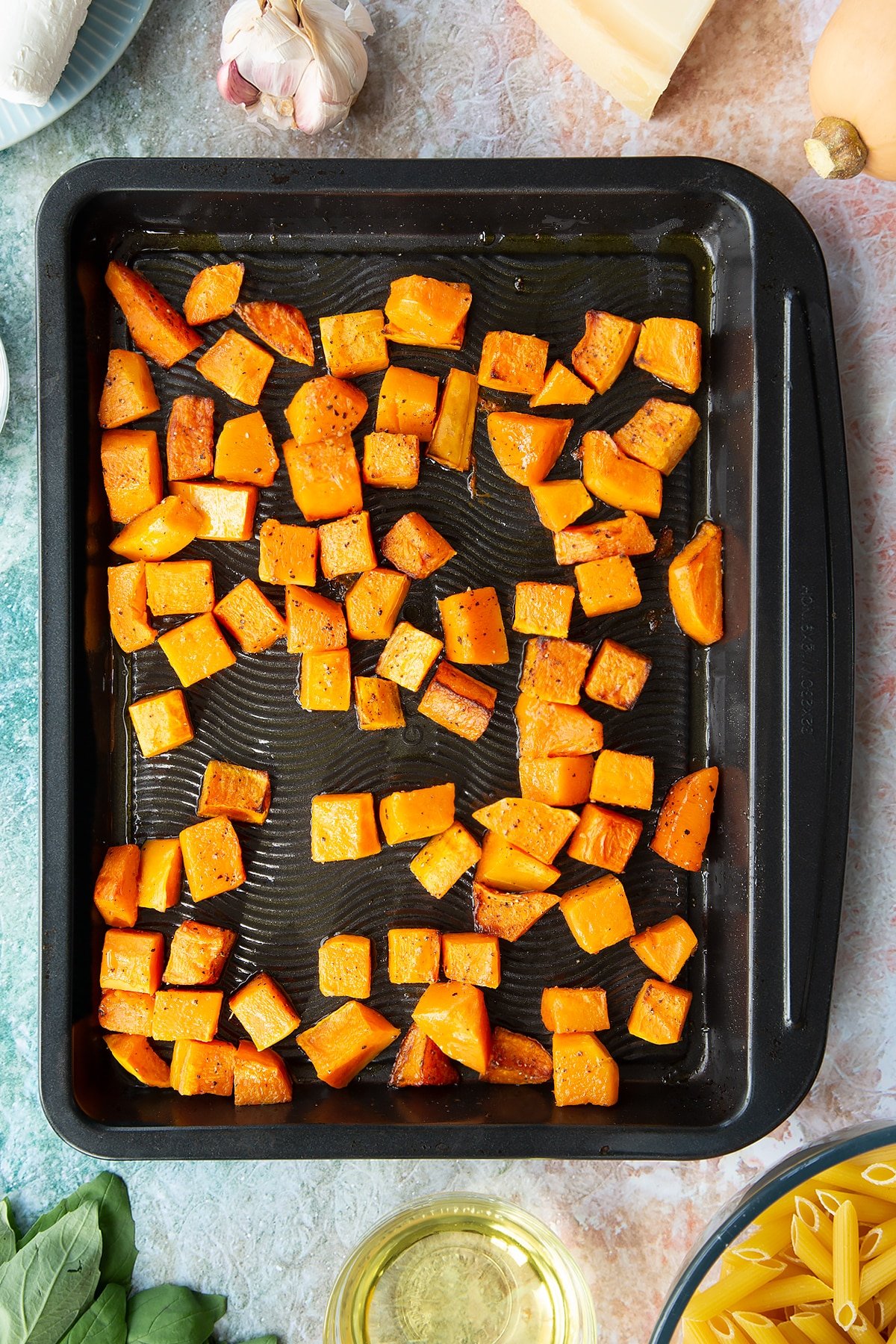
Make the pasta
When the butternut squash has been in the oven for 10 minutes, put the pasta on to cook in plenty of boiling water until al dente.
Make the pesto
Meanwhile, warm a pan over a medium heat and add the pine nuts.
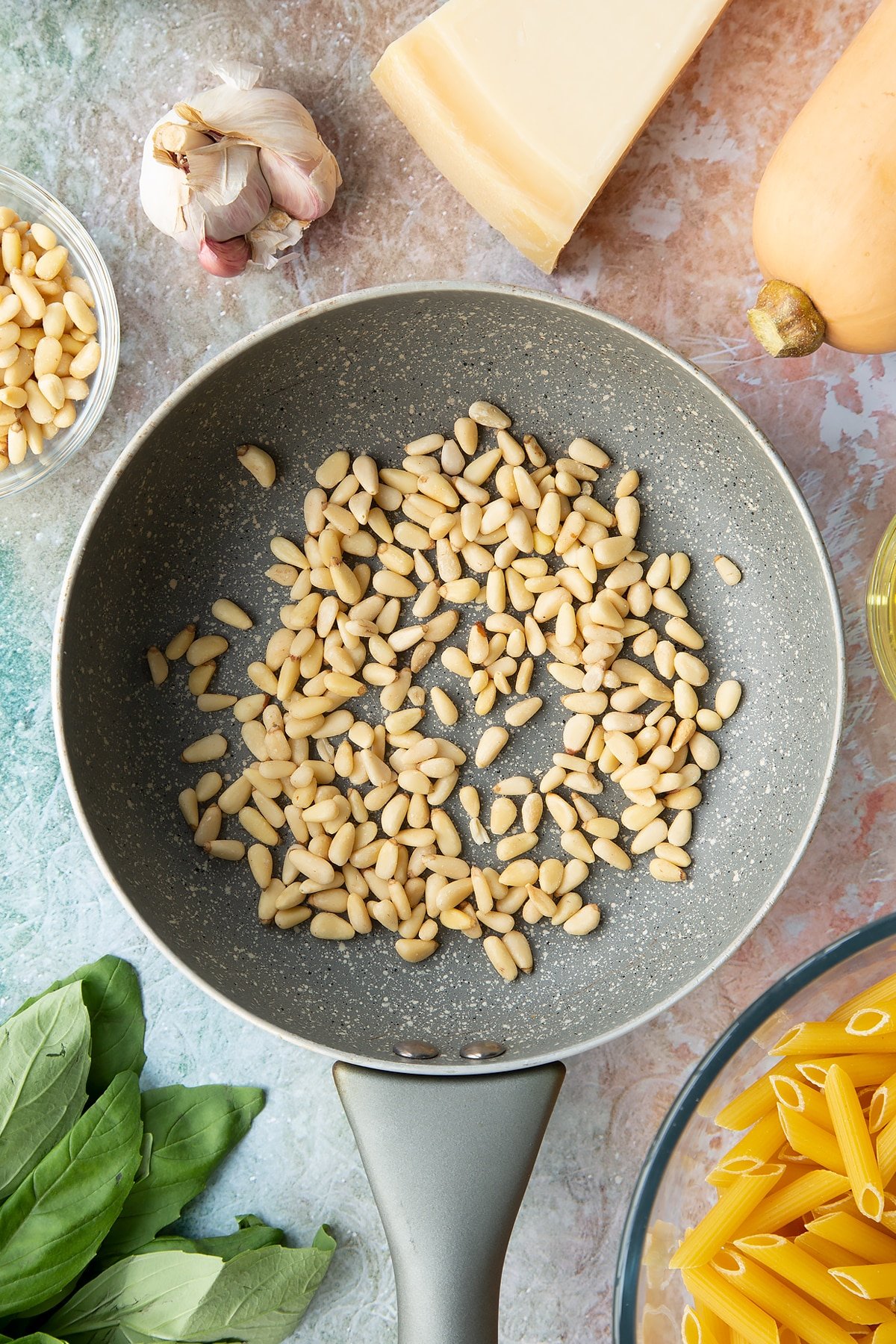
Toast for a couple of minutes until golden. Keep an eye on them and keep shaking/stirring as they can easily burn.
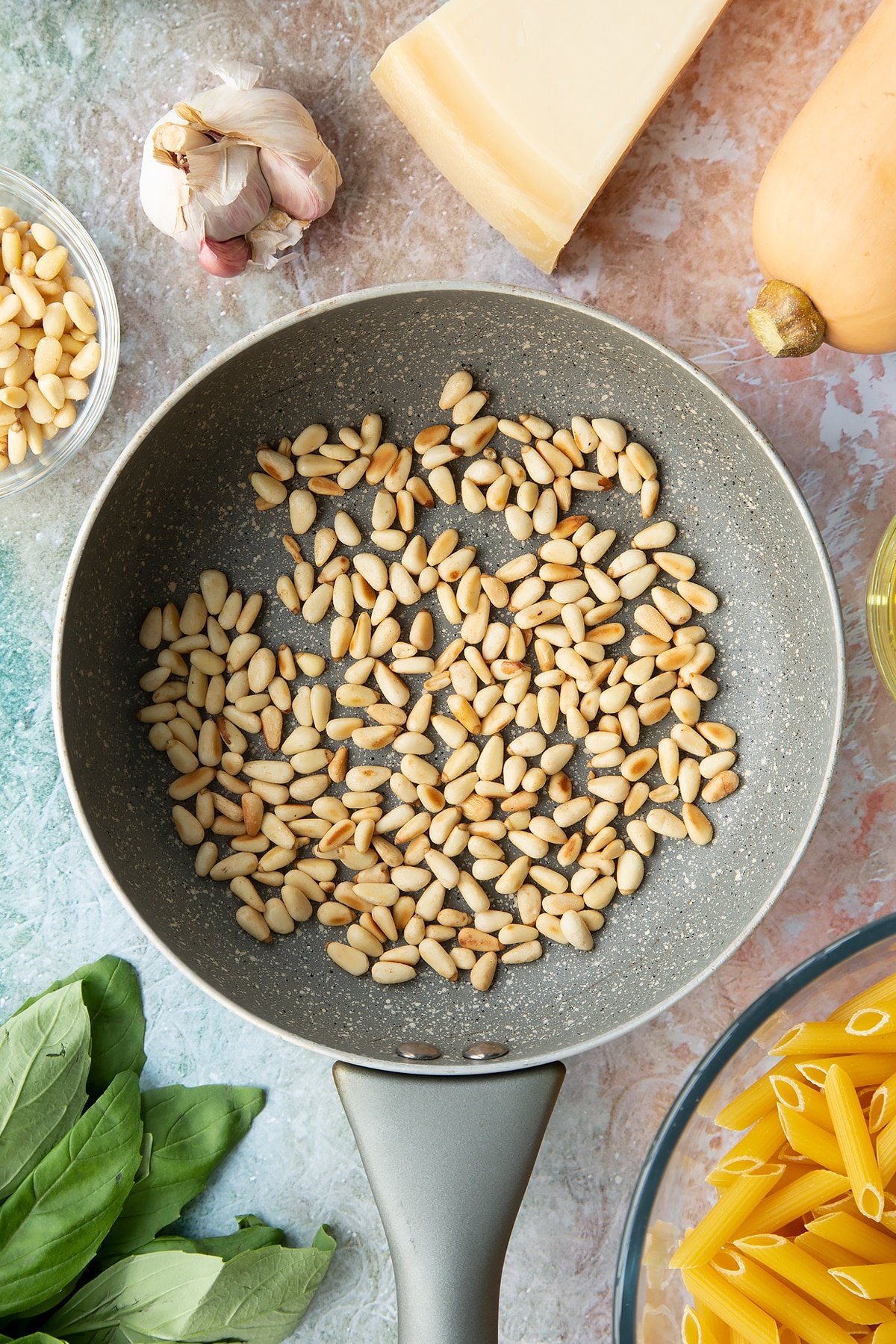
Remove the pine nuts from the pan and allow to cool in the mortar or blender bowl.
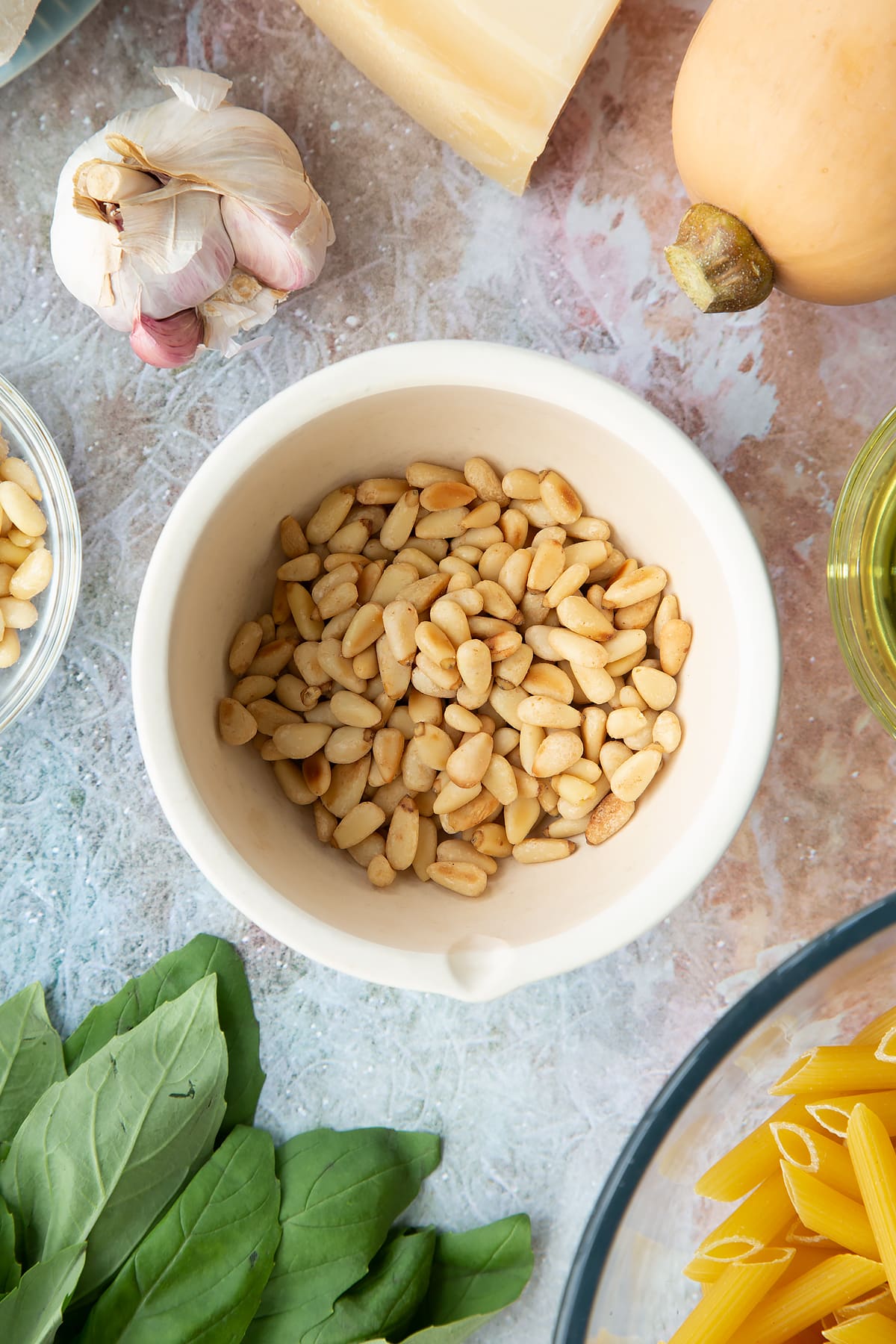
Add the garlic and a pinch of salt and pepper.
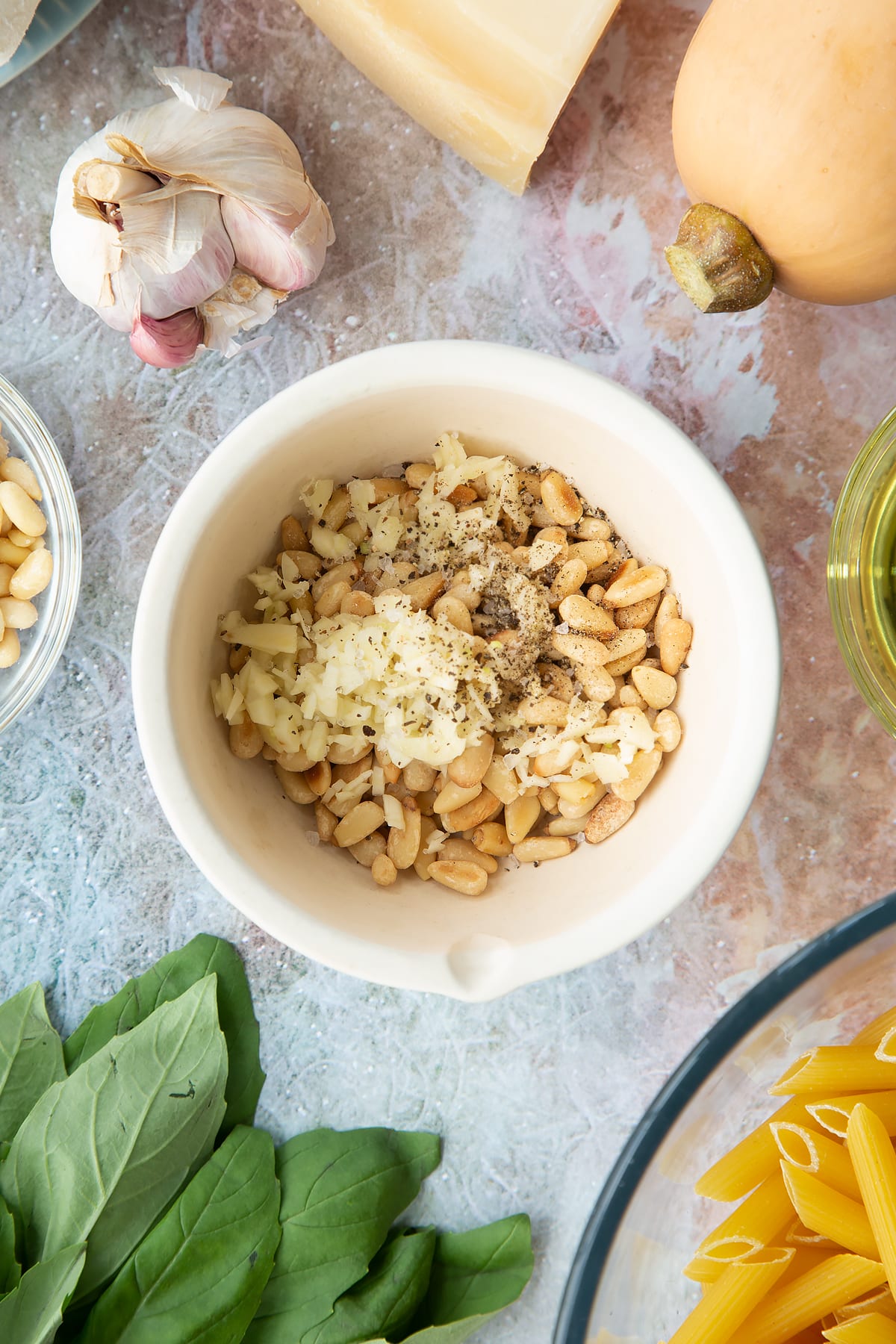
Pound with the pestle (or pulse in the blender) until coarsely crushed.
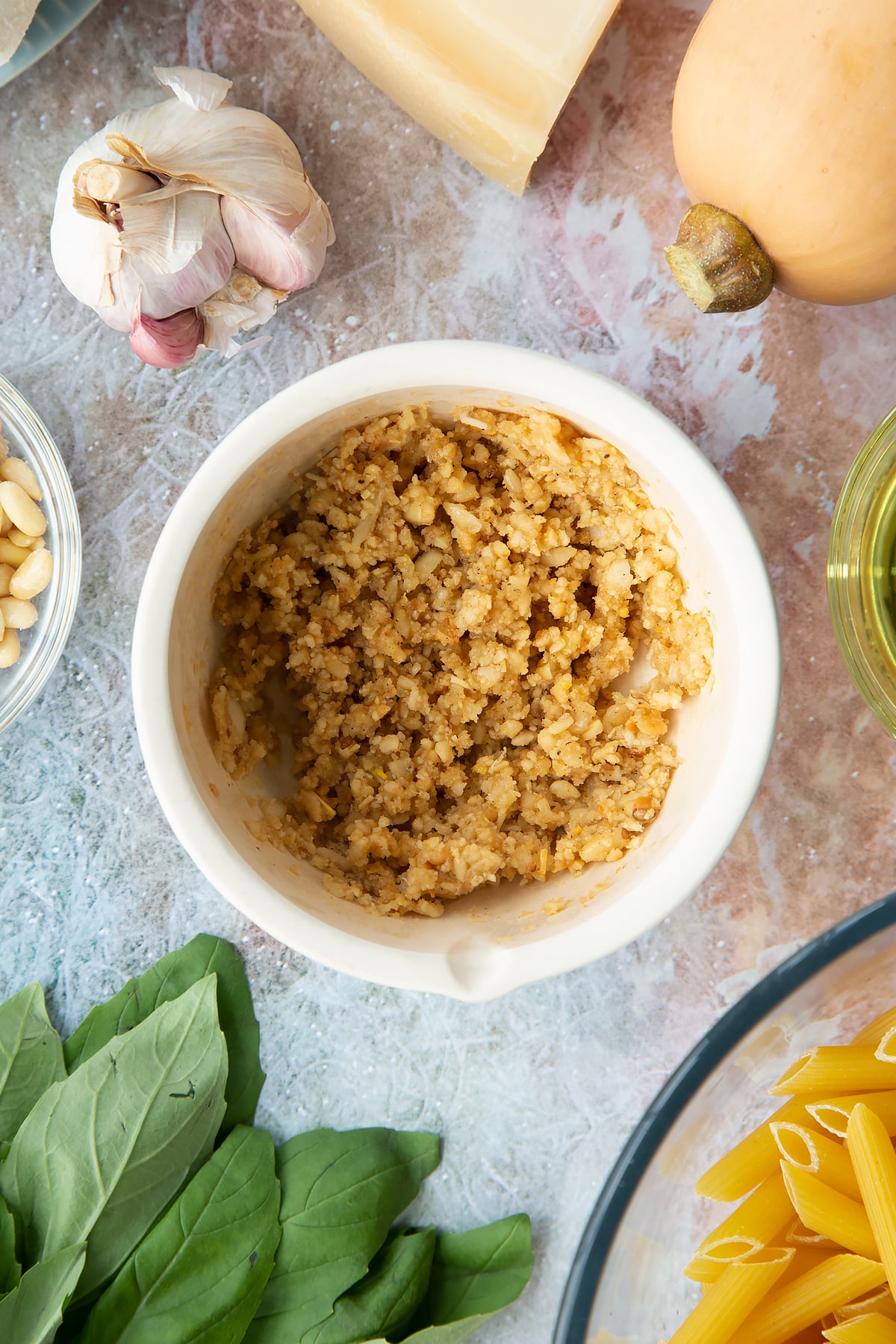
Add the basil. If you're using a pestle and mortar then add a little at a time. If you're using a blender, you can add all at once.
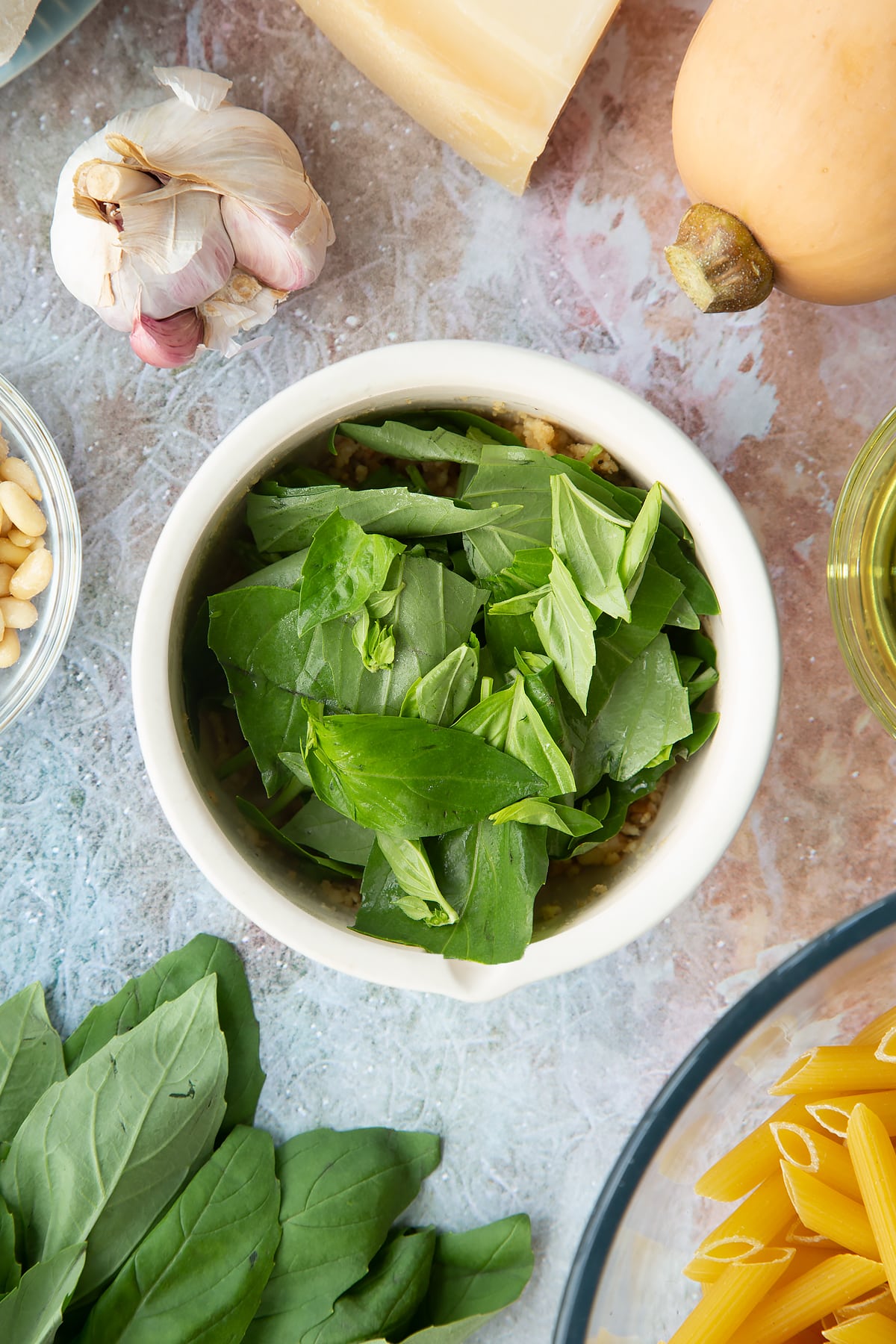
Pound with the pestle or pulse with the blender to a coarse mixture.
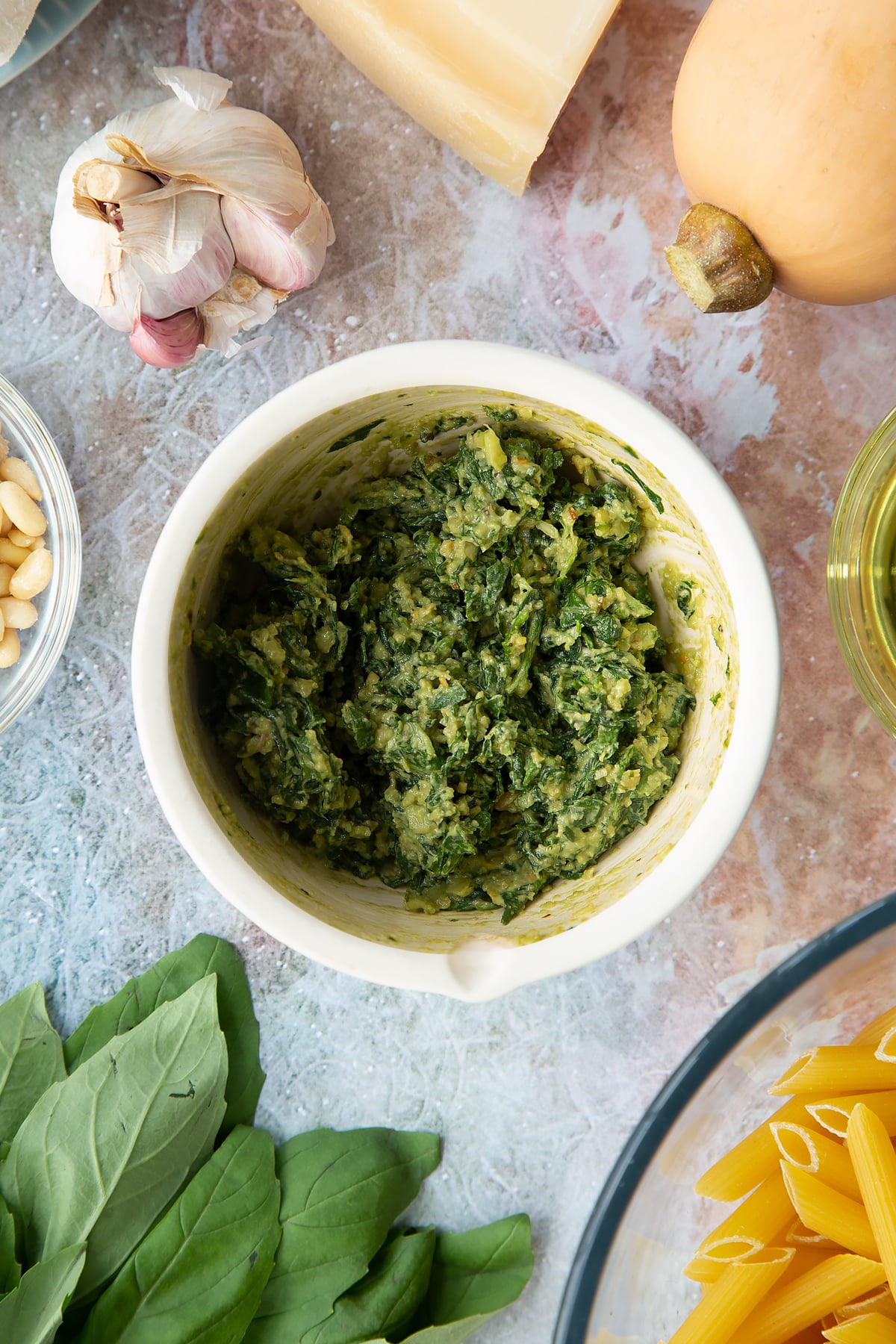
Add the cheese and olive oil.
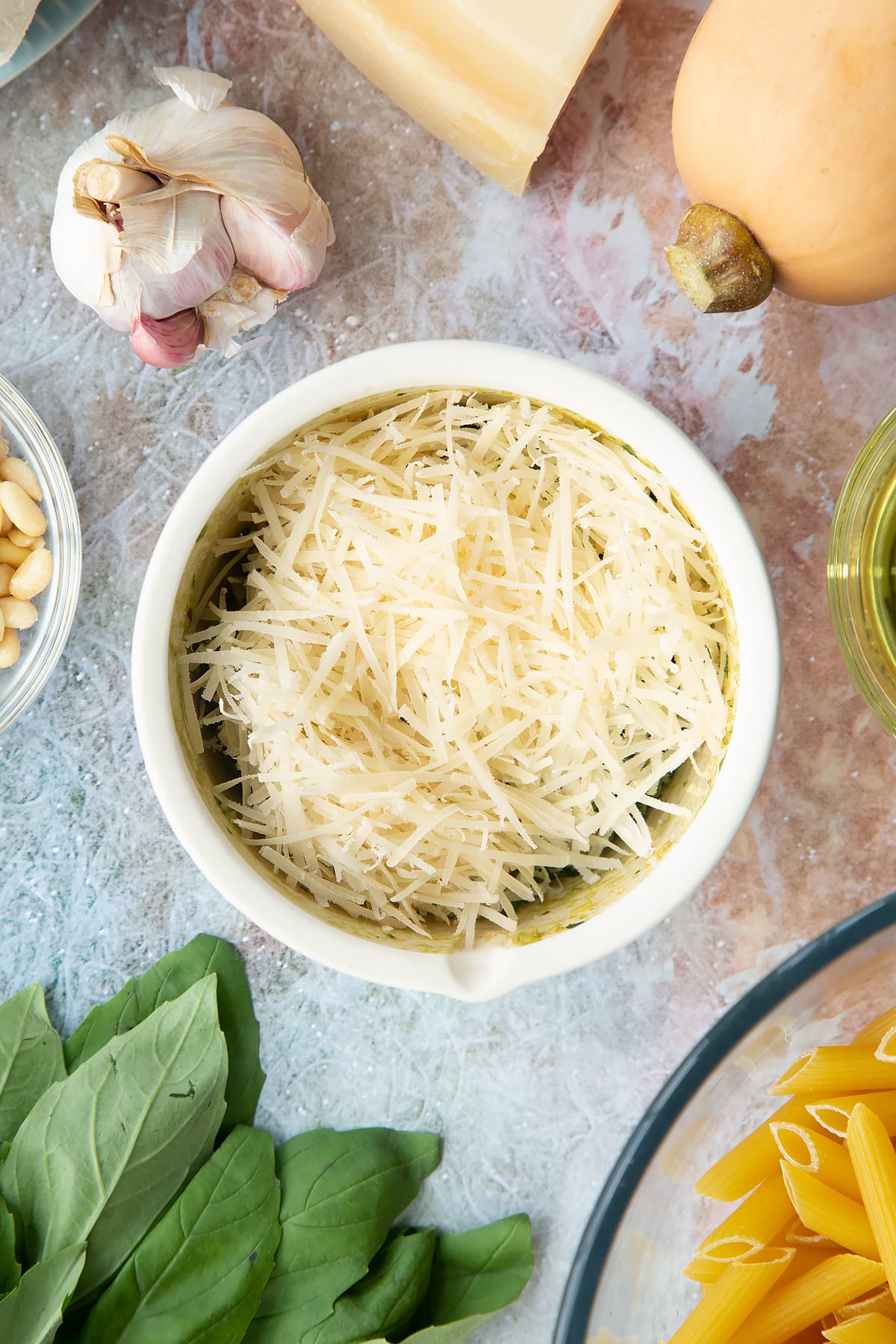
Pound/pulse again until you have a pesto. I like to keep it coarse, but you can break it down as much as you like.
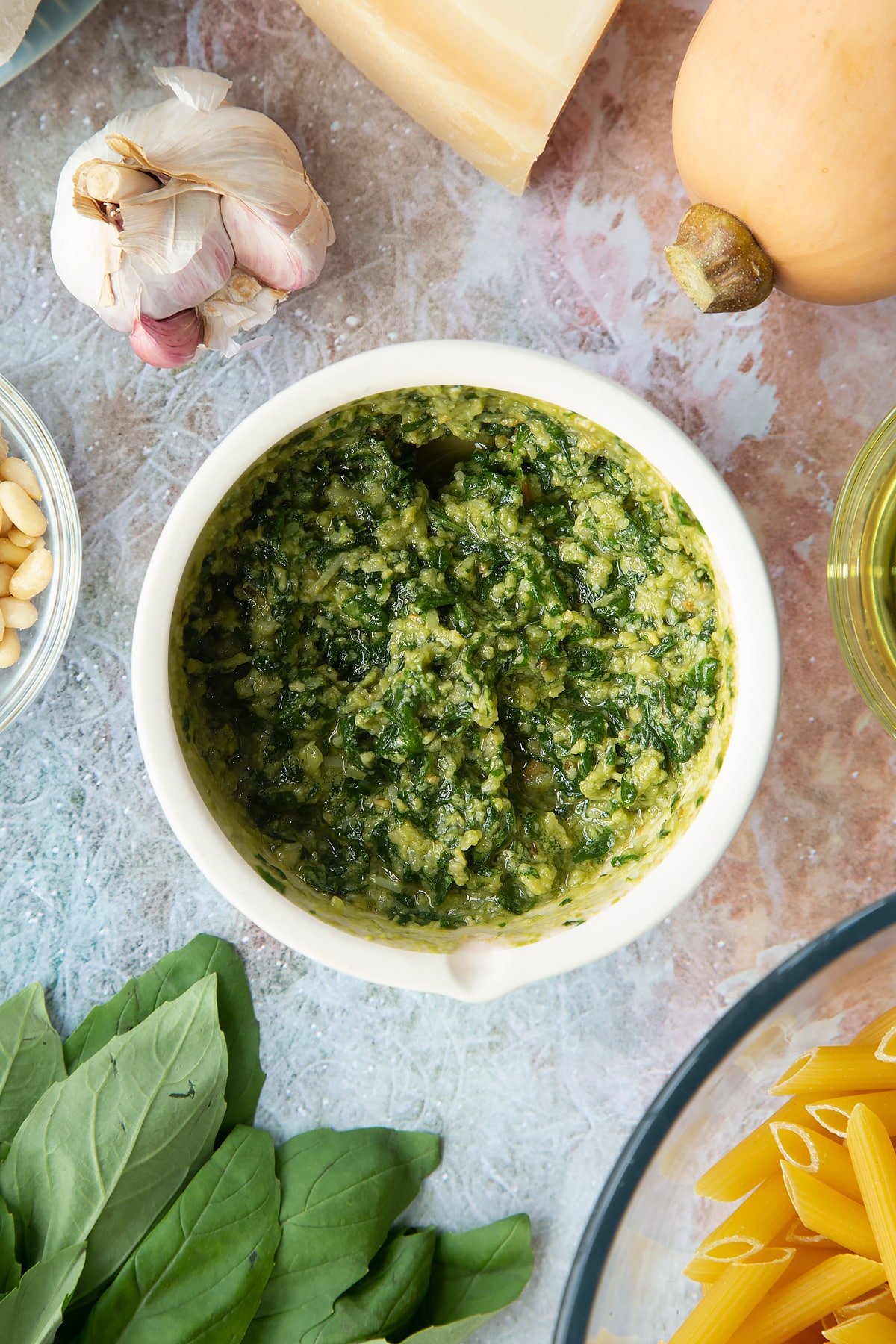
Put everything together
Drain the pasta and return to the pan.
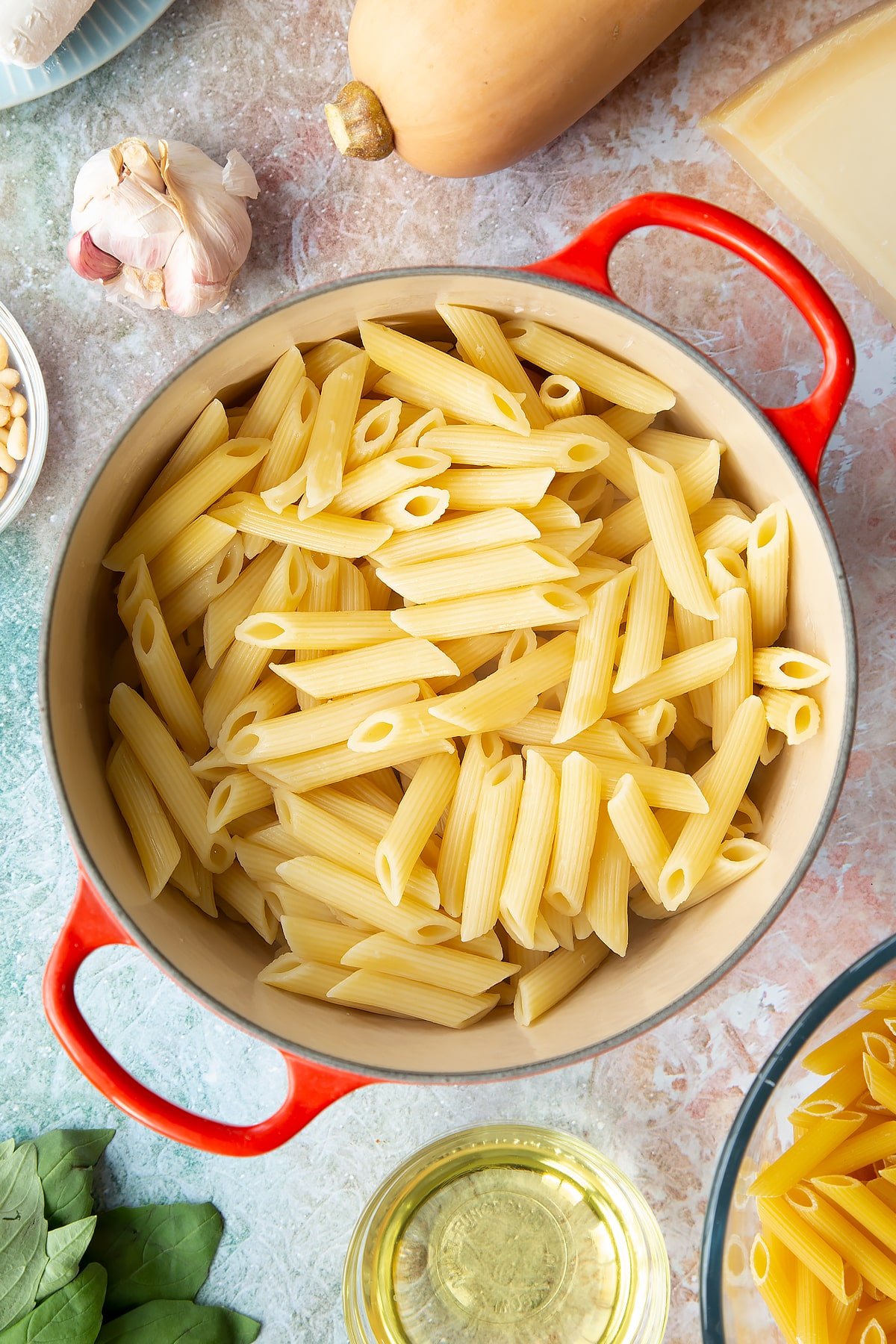
Add the pesto and stir through.
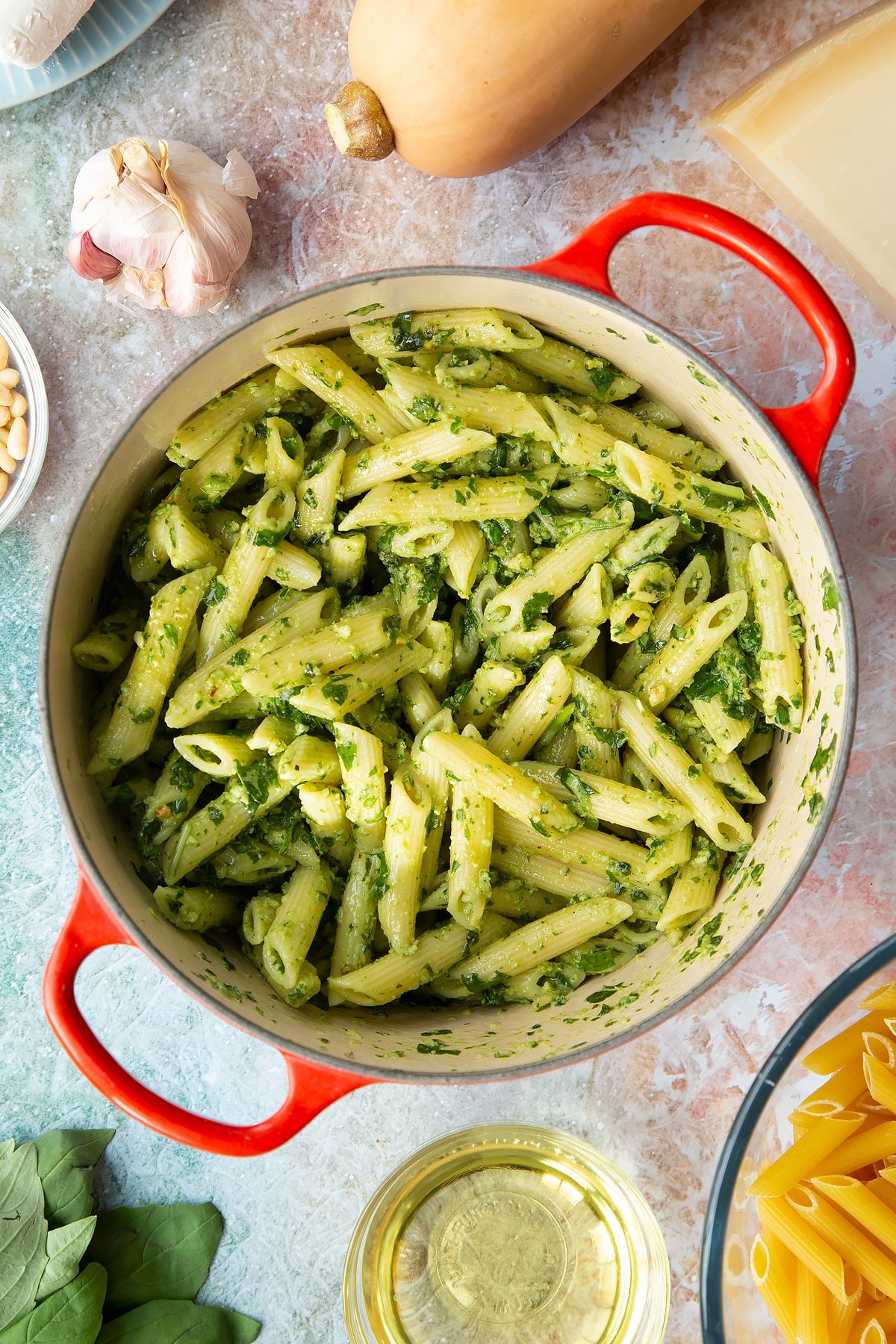
Serve to plates.
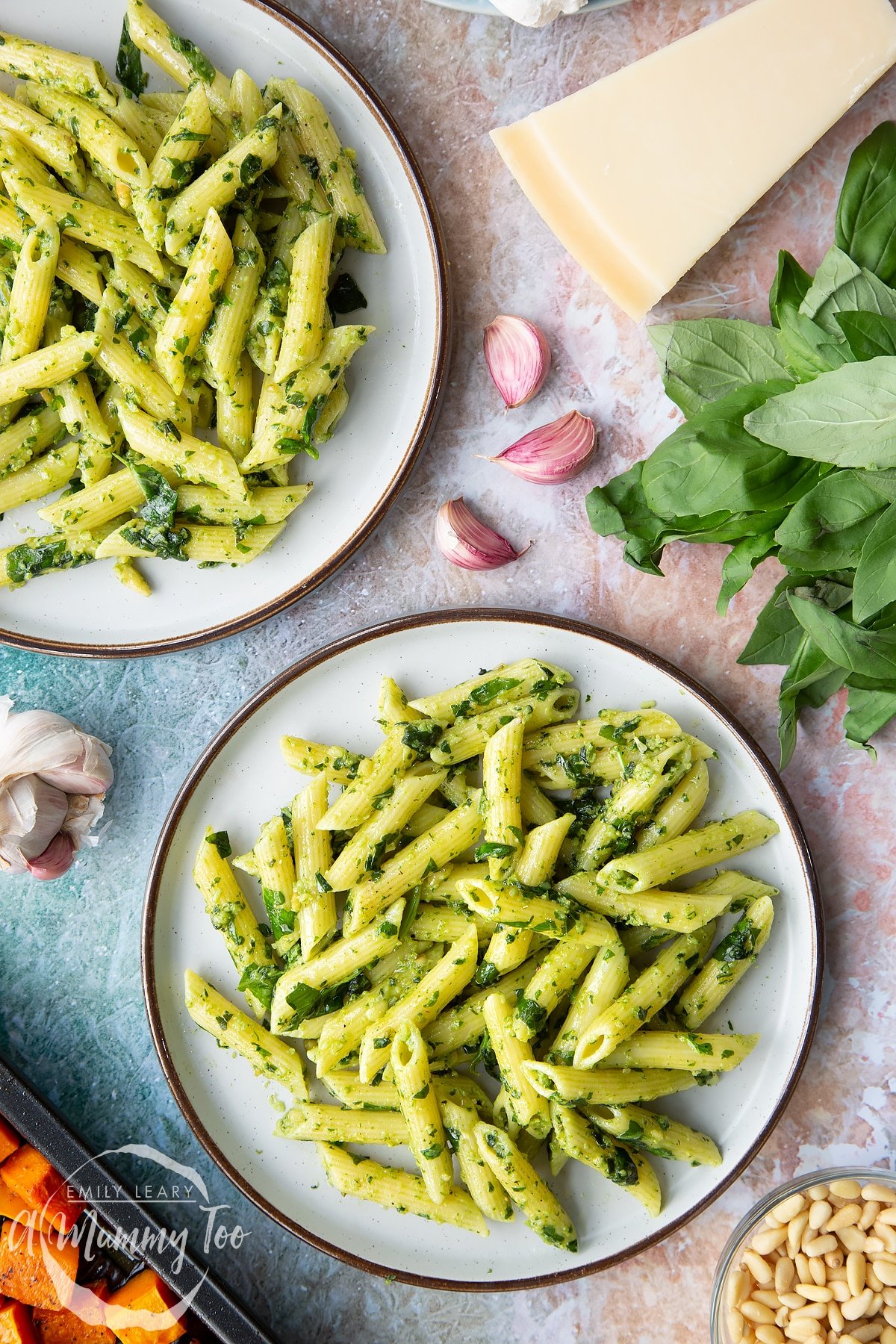
Scatter the roasted butternut squash pieces on top.
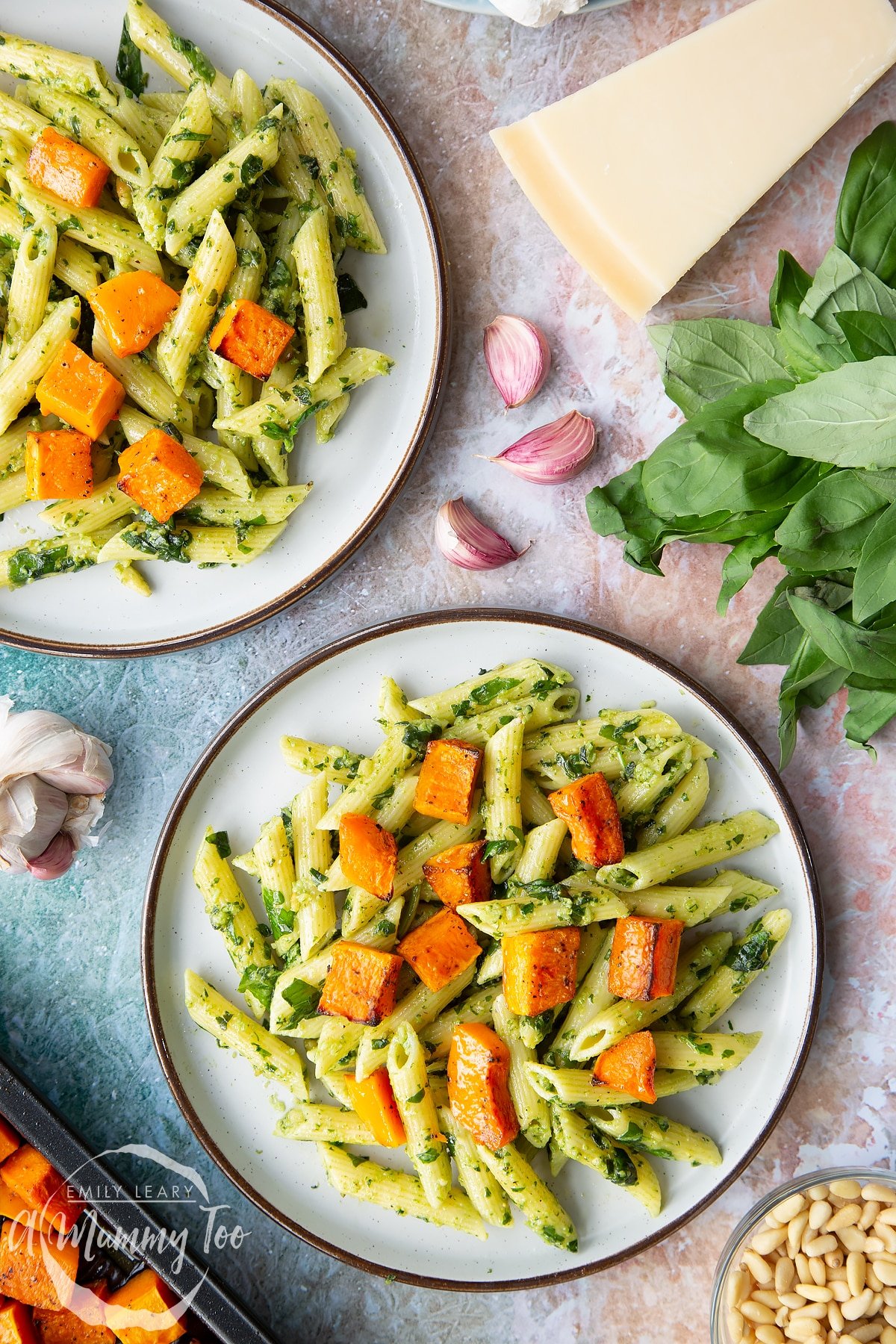
Dot with goat’s cheese and finish with more black pepper.

You're beautiful pasta is ready to serve.
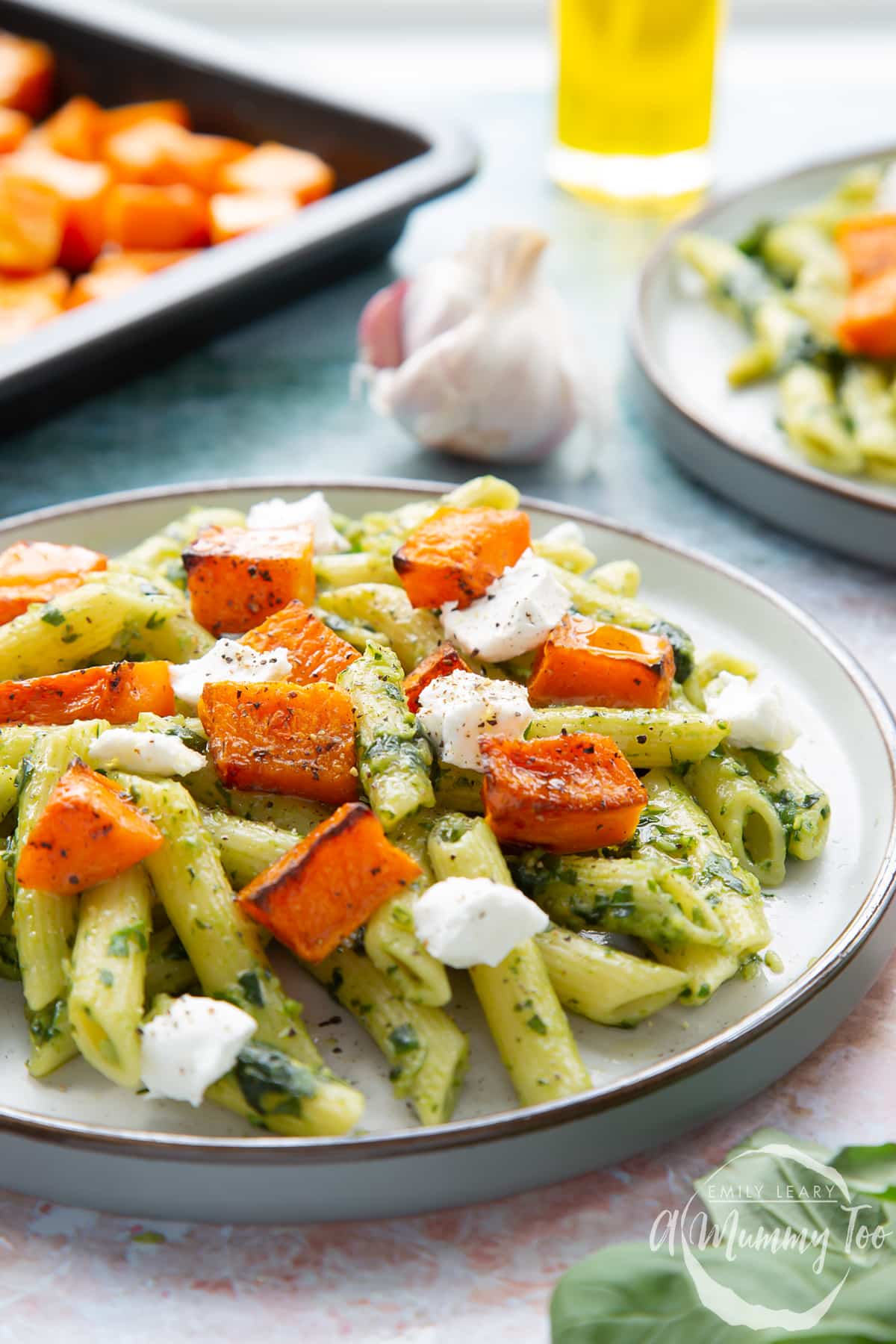
We often think of squash as a comfort ingredient, but there's something rather bright and light about this dish, don't you think? Enjoy!
Pointers, tricks and troubleshooting tips for the perfect penne with butternut squash and goat cheese
Is penne with butternut squash and goat cheese easy to make?
This is a really easy weeknight dinner that you can have on the table in 35 minutes. Each element can be prepared whilst other elements are cooking, so you can focus on one thing at a time and then pull everything together at the end.
I love making the pesto from scratch. It's so quick to do and always more enjoyable when you have the deliciousness of fresh ingredients as well as the satisfaction of making it yourself. Of course, if you want to skip that step and use jarred pesto, you can!
Will I need any special equipment for this penne butternut squash recipe?
All the equipment you need should be easy to find in most kitchens.
You'll need standard things like a chopping board and knife to prepare the squash, and an oven tray to roast it on. You'll also need a large pan to cook your pasta in and either a small blender or mortar and pestle to bash the pesto.
There is a full list of suggested equipment on the recipe card below.
Where can I buy butternut squash?
Butternut squash should be pretty easy to come by in most supermarkets all year round, or at your local farmer's market at the right time of year.
It's in season from September onwards and keeps well when stored correctly. Keep your squash somewhere cool and dark, that is well ventilated and it can keep for up to 3 months, obviously depending on how long it was stored before purchase.
If you keep butternut squash in the fridge or out on the counter, it will deteriorate more quickly. Butternut squash should feel firm, and heavier than it looks because when they are freshest they have a high water content that reduces over time.
You can buy frozen butternut squash chunks but I find they're not the best for roasting as they tend to go rather mushy.
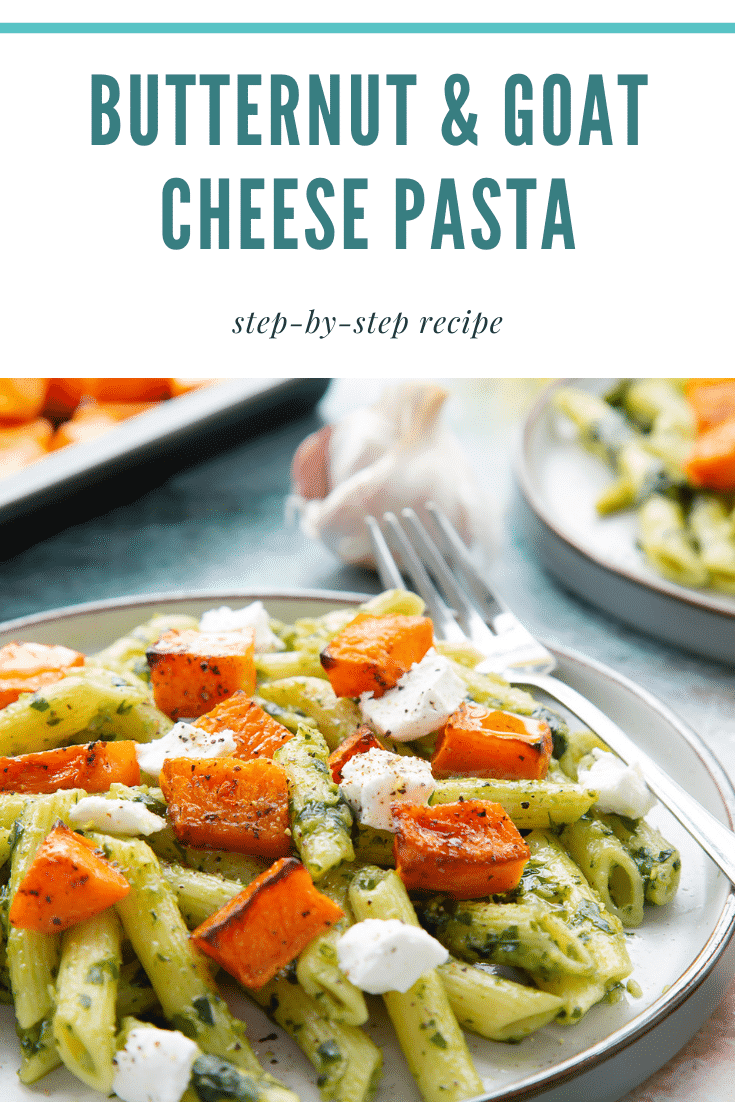
How can I tell if goat's cheese gone off?
The first thing to check is the Best Before or Use By date on your cheese. With Best Before dates, food may still be safe to eat after this date, so you'll need to check for signs of spoilage. In contrast, Use By dates indicate when a food is no longer safe to eat even if it looks as smells fine, so it's important to follow these.
Make sure to store your cheese correctly, leave it in the wrapper and keep it in the fridge.
When you come to use your cheese, make sure there are no signs of mould. This can be a little tricky with cheeses that have a rind on them, as this is a type of mould itself although one that is safe to eat. You're looking for the fuzzy kind of white or greeny-blue mould, which isn't safe to eat.
Unlike hard cheeses where you can cut the mould off and still eat the remaining cheese, it's not safe to do this with most goat cheeses as they tend to be soft, so the mould can easily track deep inside the cheese, even if you can't see it.
Is this penne butternut squash with goat cheese suitable for vegetarians?
It's very straightforward to make this recipe vegetarian by making sure to use a hard cheese in the pesto that doesn't contain rennet. Double check that the goat cheese is suitable too!
Quite a few supermarkets have an own-brand Italian style hard cheese that is similar to Parmesan but made without animal rennet.
Is this penne butternut squash with goat cheese suitable for vegans?
This recipe contains two different cheeses, neither of which are not vegan.
The good news is that more vegan cheese alternatives are becoming available, so you should be able to find suitable options.
For the vegan hard cheese, my personal favourite is Violife Prosociano Wedge. You could also try their Greek White Block in place of the goat's cheese - it's designed to taste like feta, which should work well.
Make sure to check that all of the other ingredients you use are suitable for vegans too, plus anything else you intend to serve the pasta with.
Is this penne butternut squash with goat cheese gluten-free?
For this recipe, I've used wheat-based penne pasta, but you could easily use your favourite gluten-free pasta instead.
Make sure to check that all of the other ingredients you use are gluten-free too, plus anything else you intend to serve the pasta with.
Is this penne and butternut squash with goat cheese keto-friendly?
As the core of this recipe is pasta, which is carbohydrate-based, this would not be keto-friendly. If you wanted to make a keto version, you could use courgette spaghetti instead.
You may also need to be mindful of the amount of butternut squash you use. Depending on your keto plan, butternut squash might also be too high in carbohydrates. If so, consider using less butternut squash or a more keto veg option such as broccoli.
Is this penne and butternut squash with goat cheese recipe healthy?
This is a well-balanced midweek meal that you can enjoy as part of a balanced diet. It's a good source of protein for a vegetarian diet, with vitamins and minerals from the butternut squash, and long-lasting energy from the pasta.
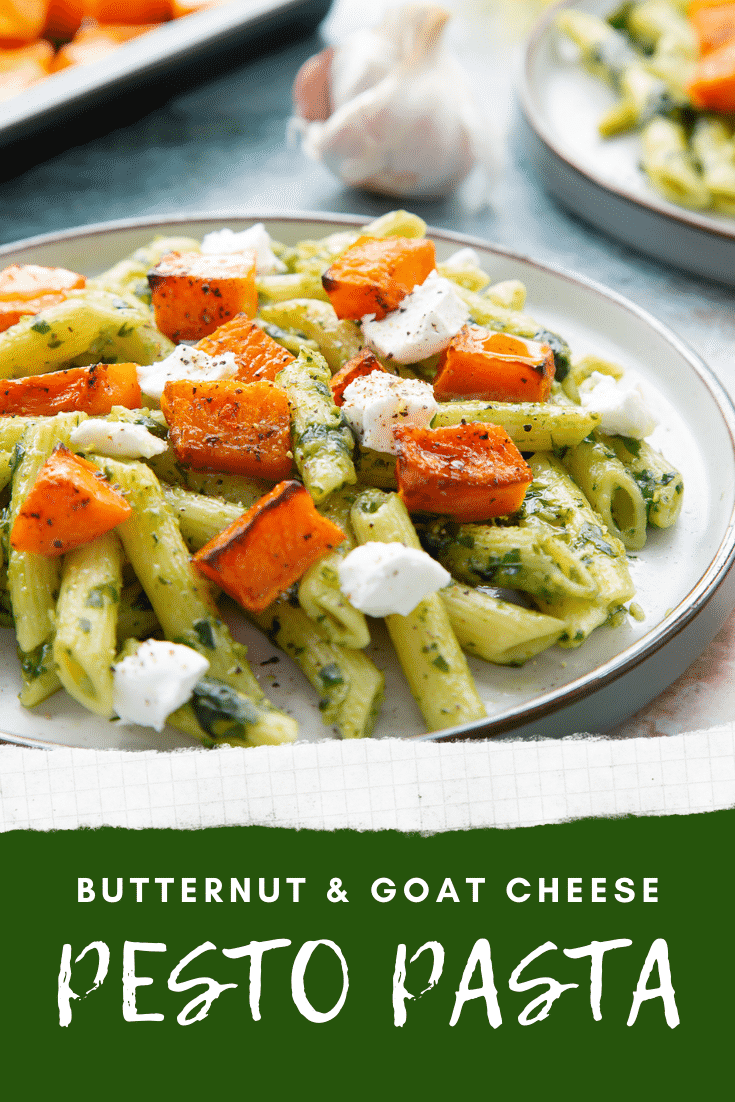
Is this penne with butternut squash with goat cheese safe to eat while pregnant?
It's important that you use goat cheese and Parmesan/hard cheese that are made with pasteurised milk. In addition, you should avoid using goat cheese that is mould ripened or has an outside rind. The NHS explains about different cheeses here.
Make sure all the ingredients are in good condition and this meal is prepared safely and hygienically.
A Mummy Too does not offer medical advice. Please seek help from a medical professional if you need further information or have any concerns.
Is penne and butternut squash with goat cheese suitable for babies and toddlers?
This is a perfect meal for all the family, and this recipe would be suitable for a baby that is over 6 months old, sitting up unaided, and comfortable eating solid food.
As with during pregnancy it's important to make sure cheese fed to young children is made with pasteurised milk, and that you avoid cheese that is mould ripened or has an outside rind.
If you are making this for young children or babies, leave out the salt. The NHS explains why here. There are pinches of salt throughout this recipe so you can leave these out, and the adults can salt their meal at the table if they wish.
Depending on the pasta shape may need to cut these into manageable pieces for little ones. You may wish to roast the butternut in baton shapes that are easier for babies to hold.
Always give food at an appropriate size and shape for your baby or child. Cut small, round foods, like grapes and cherry tomatoes, into small pieces.
Always keep babies supported upright while eating and supervise your baby when they’re eating in case they start to choke.
A Mummy Too does not give medical advice. If you have any questions or concerns please speak to a health professional.
The NHS has some fantastic resources on their website on what to feed babies and young children.
What goes well with this penne butternut squash with goat cheese recipe?
This penne butternut squash is a full meal all in one. If you like, you could serve with a lovely crunchy side salad, or some fresh bread and olive oil.
This recipe is also great cold with a few handfuls of rocket leaves mixed through.
Can I make this recipe without goat cheese?
The creaminess and extra level of tangy flavour the goat cheese brings to this recipe is really lovely, but if you don't like goat cheese, or want to leave it out for any other reason, you'll still have a delicious meal. Perhaps try adding some lightly toasted pecans or a different soft cheese.
I haven’t got butternut squash can I use different veggies?
This recipe is designed around the texture and flavour of the butternut squash, but you can of course enjoy this with other veggies too.
If you're looking for a similar texture then try using pumpkin or other winter squashes. Sweet potatoes would work well too. See just below for some more ideas on different veg to try.
Can I add extra veggies to this recipe?
I like to keep this recipe simple using the butternut squash, but you can of course add more veggies if you like. Depending on how much you're planning to add, you might want to reduce the amount of pasta, or just keep any leftovers for lunch the next day.
Anything you can roast along with the squash will work. Something like broccoli is really tasty and adds another dimension to the dish. You could try peppers, cherry tomatoes cut in half, or chunks of courgette. Have a look in the fridge and see what might work.
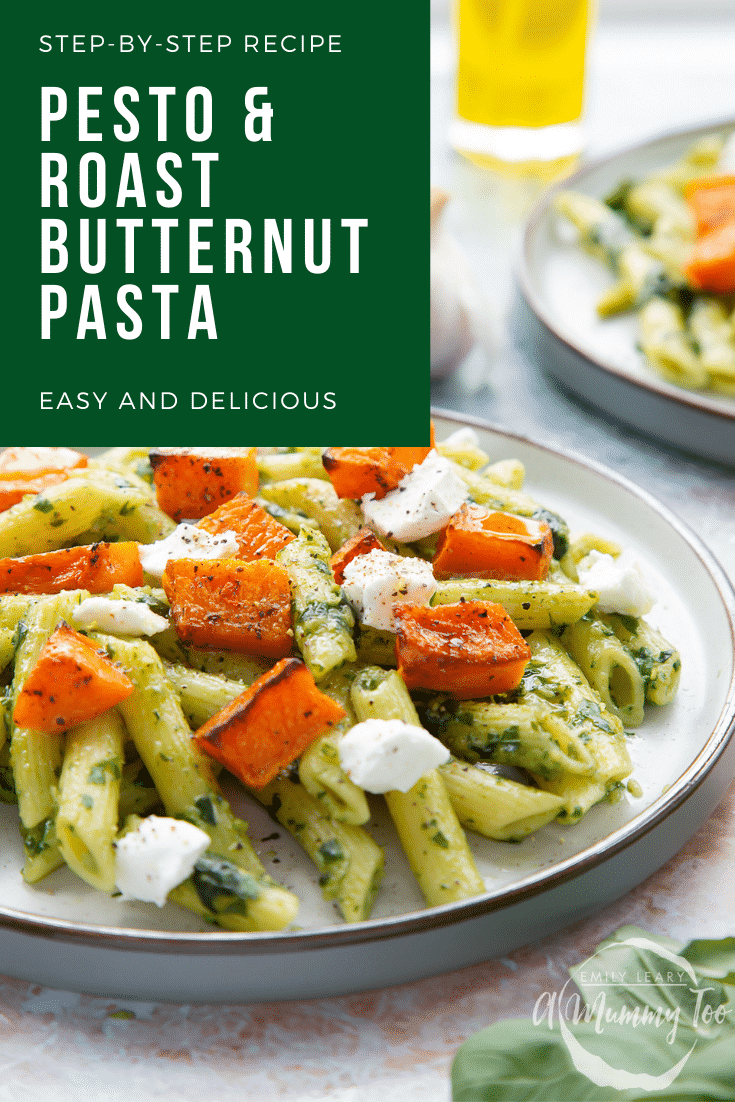
Whatever veggies you pick, make sure to use a large enough tray so the veg all fits on a single layer with a bit of space. If you overcrowd the tray, the veg will steam rather than roast and might take longer to cook.
Another way to add extra greens to this meal would be to stir through a few handfuls of rocket leaves. Or, when you're draining the pasta, put a big handful of washed spinach into the colander, then pour over pen of hot water and pasta so that the spinach steams quickly before adding back into the pan with the pasta and other ingredients.
How should I store this penne butternut squash with goat cheese?
Any leftovers of this penne pasta with butternut squash and goat cheese need to be cooled and placed in the fridge within 2 hours of making. Cover well in a bowl or transfer to a sealed container.
How long does this penne and butternut squash with goat cheese keep?
This penne butternut squash will keep in the fridge for up to 3 days. Check the date on the goat cheese too. If its Use By data is sooner than 3 days, that's also the Use By date for your meal.
Can I leave this penne recipe out on the counter?
No, for food safety reasons this recipe can't be left out on the counter for long periods of time. Once any leftovers have cooled get them into the fridge as quickly as you can and certainly within 2 hours of making.
Can I make this penne and butternut squash with goat cheese recipe ahead?
Personally, I don't really like re-heated pesto pasta as it seems to go oily and the texture isn't as good. This recipe tastes great cold so you could serve it chilled for lunch or perhaps as part of a picnic.
You can just prepare the pesto ahead, if you want to save a bit of time. Make a double batch if you like as it keeps in the fridge for up to 5 days.
Can I freeze this penne and butternut squash with goat cheese recipe?
As this recipe contains cooked pasta and fresh goat cheese I don't think it will freeze that successfully. It's best to keep any leftovers in the fridge and enjoy them cold.
Pesto can be frozen on its own, so you freeze batches in ice cube trays, if you like. Butternut squash doesn't freeze well - it tends to go mushy.
What is the best way to reheat this penne and butternut squash with goat cheese?
Rather than trying to re-heat this recipe, I would recommend having it cold.
That said, your best bet if you do want to re-heat, is to separate the elements. Lightly fry the butternut squash to reheat, gently warm the pesto pasta in a saucepan and scatter with fresh goat's cheese once served.
Can I make this penne and butternut squash recipe in a different quantity?
If you want to make more or less of this recipe then go right ahead. On the recipe card below you'll see the servings are set to make 4 portions.
To change this to the number you want to make just click on it and a little slider will pop up. You can move the slider up or down to get the amount you want to make. All the ingredient quantities will update automatically for you so that everything is in the right ratios.
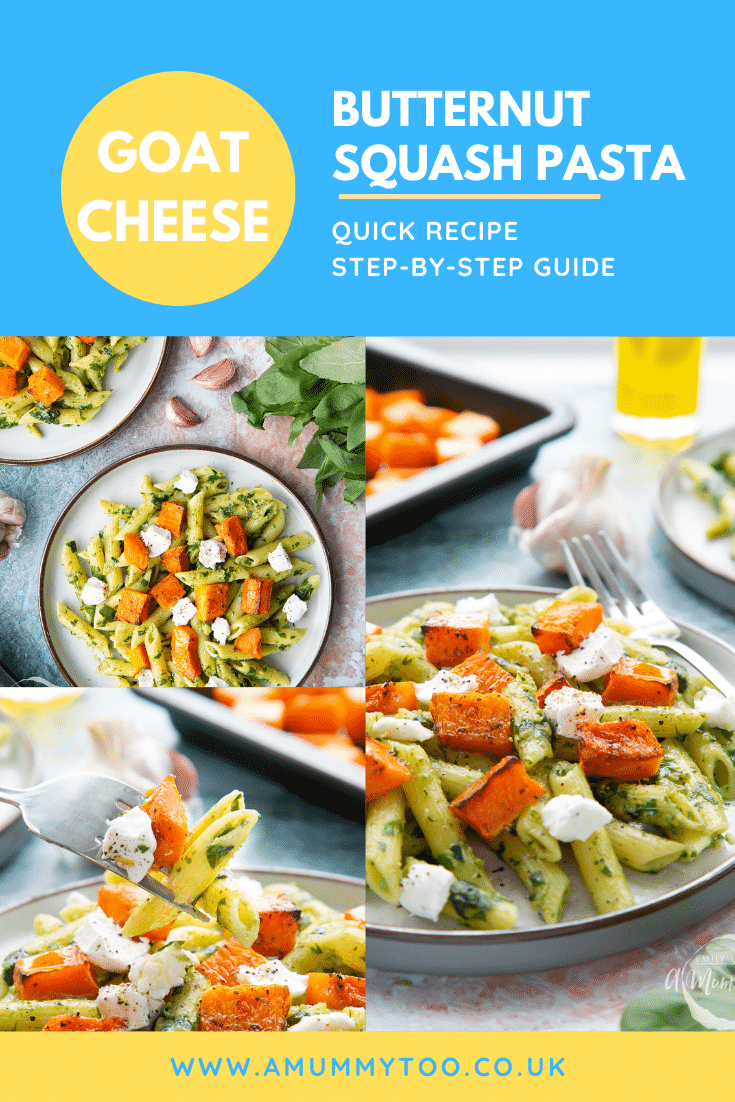
Can I make this recipe with a food processor?
You can make the pesto element of this recipe in a food processor if you like.
Smaller food processors or personal blenders will work fine, but if the bowl of your food processor is quite large it might throw the ingredients to the sides rather then properly breaking them up. In such a case, it would be best to use a mortar and pestle.
Alternatively, you could make a double batch of pesto, better suited to a larger food processor. Pesto keeps well in the fridge for up to 5 days and is great to have on hand for other recipes.
Can I boil the butternut squash for this recipe, instead of roasting in the oven?
I recommend roasting the squash as I find it has a texture that better compliments the rest of the dish - a crisp, sweet outer and fluffy, soft inner.
Boiling the squash is an option if you're short of time. Cover the squash in a pan with water and pop over a medium heat. Bring to the boil and then put a lid on, turn the heat down to low so the pan can simmer. It will take about 7-10 minutes to cook. Check your squash regularly to make sure it still has a bit of firmness, drain and set aside until you need it.
How can I make sure this penne butternut squash with goat cheese is perfectly cooked?
I love this recipe as you have enough time to make the pesto and cook the pasta whilst the butternut squash roasts in the oven. It's a good idea to get all the ingredients out to start with so that you have everything on hand.
Make sure to cut the butternut squash down to about 2.5cm (1 inch) pieces so that they roast quickly. Don't overcrowd the roasting tray. Give the butternut squash plenty of room so each piece roasts evenly.
Cook your pasta in plenty of salted water. Follow the packet instructions for timings, but remember to knock a minute or two off the time if you like it al dente (ie with a bit of bite). 10 minutes is usually about right for my taste.
When it comes to the pesto, the main thing is to keep an eye on the pine nuts as they can quickly burn. You want a little colour change, so keep jiggling the pan until most of the pine nuts are nicely toasted.
It's great fun to bash everything in a mortar and pestle, which is the traditional way to make pesto and means you can taste as you go, adding more of any of the ingredients to suit your taste. However, if speed is of the essence then pile everything into a small blender and blitz away! Pulse if you're prefer to keep some texture as a blander can quickly puree everything down.
Why did my penne and butternut squash with goat cheese turn out dry?
Your basil should release moisture as it's broken down and the oil will help ensure the final pasta is beautifully coated and delicious.
However, natural ingredients can vary, so a simple trick is to save a small amount of pasta water back to add to the mix if it's dry. Before you drain the pasta scoop out a ladleful into a mug and when you come to mix everything together add in a little water if you need to.
If you forget to save some pasta water, an extra drizzle of olive oil can help bring everything together nicely too.
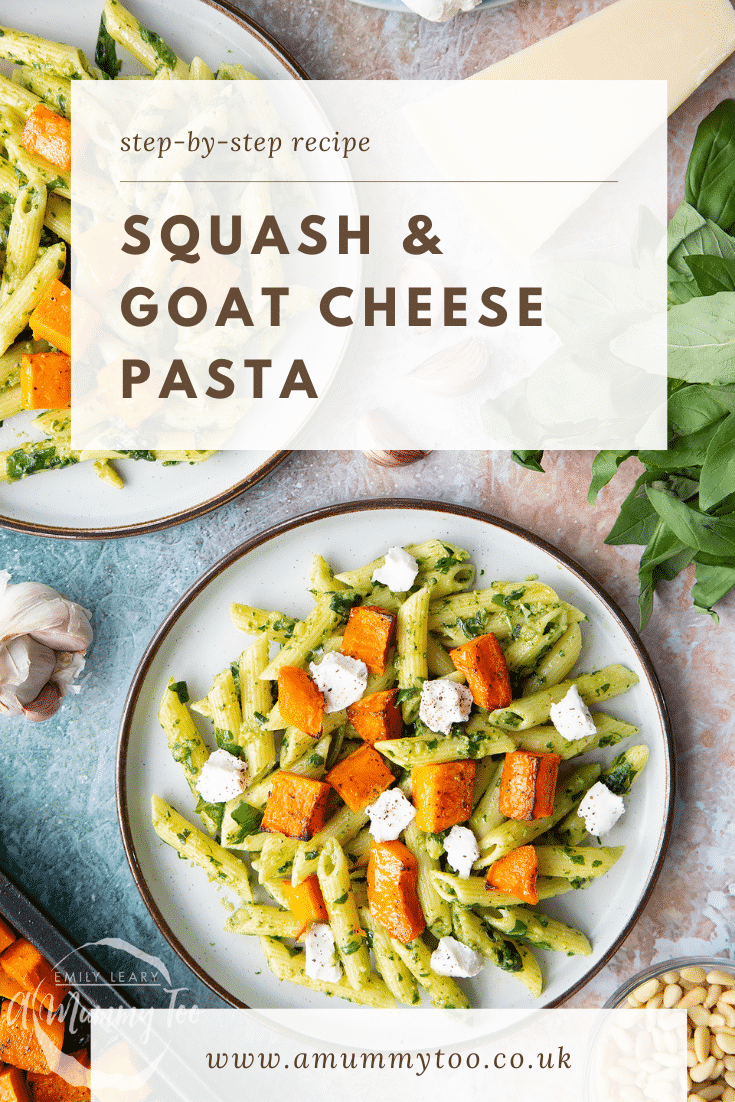
Why did my penne and butternut squash with goat cheese turn out wet and sloppy?
Pasta when cooked for too long will have a tendency to turn out very soft and a bit wet. Your meal will still be nice, though it might be lacking a bit in texture. Throw over a few extra pine nuts to add some bite if you like.
Personally, I only cook my pasta for about 10 minutes - I think that's plenty to retain a bit of bite, but definitely not over 12 minutes.
I find it really helpful to set timers as I'm cooking, especially if there are a few elements to make, and other distractions going on in the kitchen. Give this a go next time and let me know how you get on.
How can I add/change the flavours in this dish?
There are loads of ways you can adapt this recipe to whatever is in the cupboard or fridge and to suite different tastes and preferences.
The pasta element can be substituted for different shapes, and wholemeal pasta works really well with goat cheese and butternut squash too. Check the pack as wholemeal pasta sometimes takes a little bit longer to cook.
If you have the time, rinse the fleshy bits off the butternut squash seeds and scatter them on a tray to toast in the oven for a few minutes. They'll be perfect sprinkled on top of your pasta, or as a crunchy snack.
You can also add other types of veg like broccoli or peppers. And try out different cheeses. Mozzarella works well. A salty, mild feta or a soft blue cheese would be yummy too.
Where does the name penne come from?
Penne pasta was created in 1856 using an extrusion method, where the dough is forced through a metal die to create tubes, that are then cut on the diagonal with a specially designed machine patented by Giovanni Battista Capurro.
The name comes from the Italian word for feather penna, or penne in the plural form. This also means pen, since feathers would have been used as quills at the time. The shape at the end of penne pasta looks a bit like the nib of a fountain pen or the point on a quill, which is why it was given this name.
Print this penne with butternut squash and goat cheese recipe
Penne with Butternut Squash and Goat Cheese Recipe
Ingredients
For the roast butternut squash
- 500 g (1.1 lb) butternut squash flesh cut into 2.5cm (1 inch) pieces
- 2 tbsp olive oil
- pinch salt and black pepper
For the pesto
- 45 g (1.6 oz) pine nuts
- 50 g (1.8 oz) fresh basil
- 2 cloves (2) garlic
- 30 g (1.1 oz) hard cheese Parmesan or vegetarian if required
- 65 ml (2.2 floz) olive oil
- salt and black pepper to taste
For the pasta
- 300 g (10.6 oz) penne pasta
- pinch salt
- 125 g (4.4 oz) goat’s cheese
Equipment
- Medium roasting pan 35x25cm (14x10")
- Food processor or pestle and mortar
Instructions
Make the roasted butternut squash
- Preheat the oven to at 220C (200C fan).
- Put the butternut squash chunks in a non-stick roasting tray. Drizzle with oil and season with salt pepper.
- Roast for 20-25 mins until the edges are browned and the insides are soft.
Make the pasta
- When the butternut squash has been in the oven for 10 minutes, put the pasta on to cook in plenty of boiling water until al dente.
Make the pesto
- Meanwhile, warm a pan over a medium heat and add the pine nuts. Toast for a couple of minutes until golden. Keep an eye on them and keep shaking/stirring as they can easily burn.
- Remove the pine nuts from the pan and allow to cool in the mortar or blender bowl.
- Add the garlic and a pinch of salt and pepper. Pound with the pestle (or pulse in the blender) until coarsely crushed.
- Add the basil. If you're using a pestle and mortar then add a little at a time. If you're using a blender, you can add all at once. Pound with the pestle or pulse with the blender to a coarse mixture.
- Add the cheese and olive oil. Pound/pulse again until you have a pesto. I like to keep it coarse, but you can break it down as much as you like.
Put everything together
- Drain the pasta and return to the pan. Add the pesto and stir through.
- Serve to plates. Scatter the roasted butternut squash pieces on top, dot with goat’s cheese and finish with more black pepper.
Video
Notes
Nutrition
Pin this penne with butternut squash and goat cheese
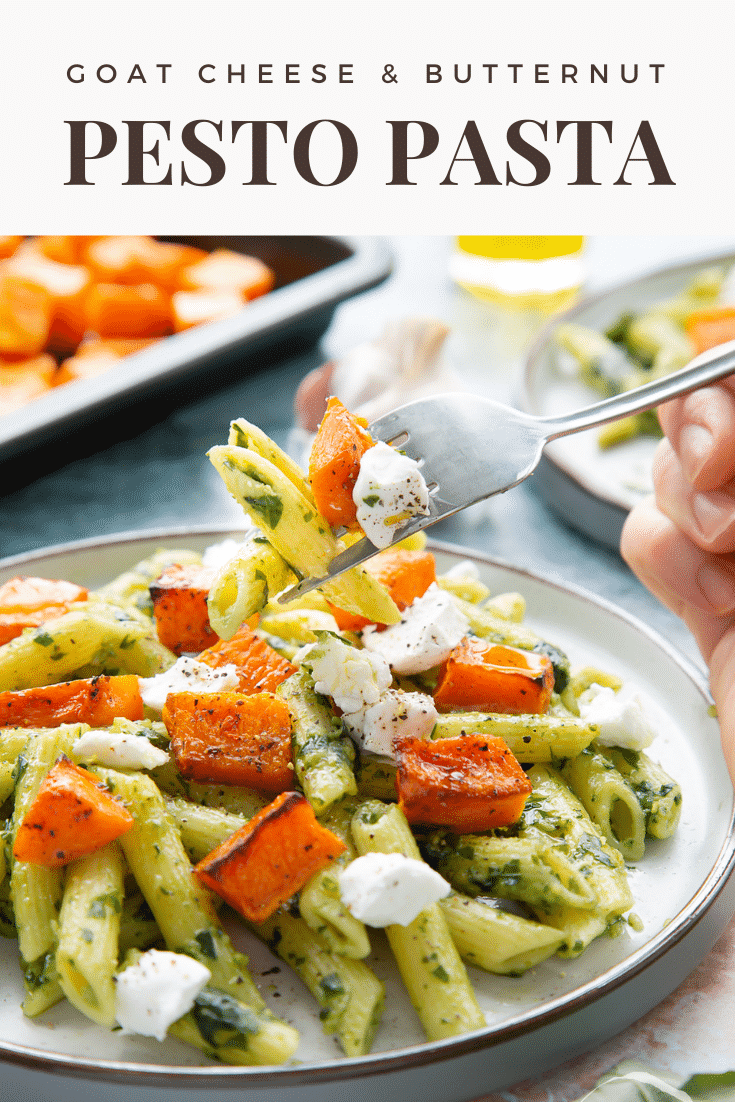
More pesto recipes to try
Have you got my book?
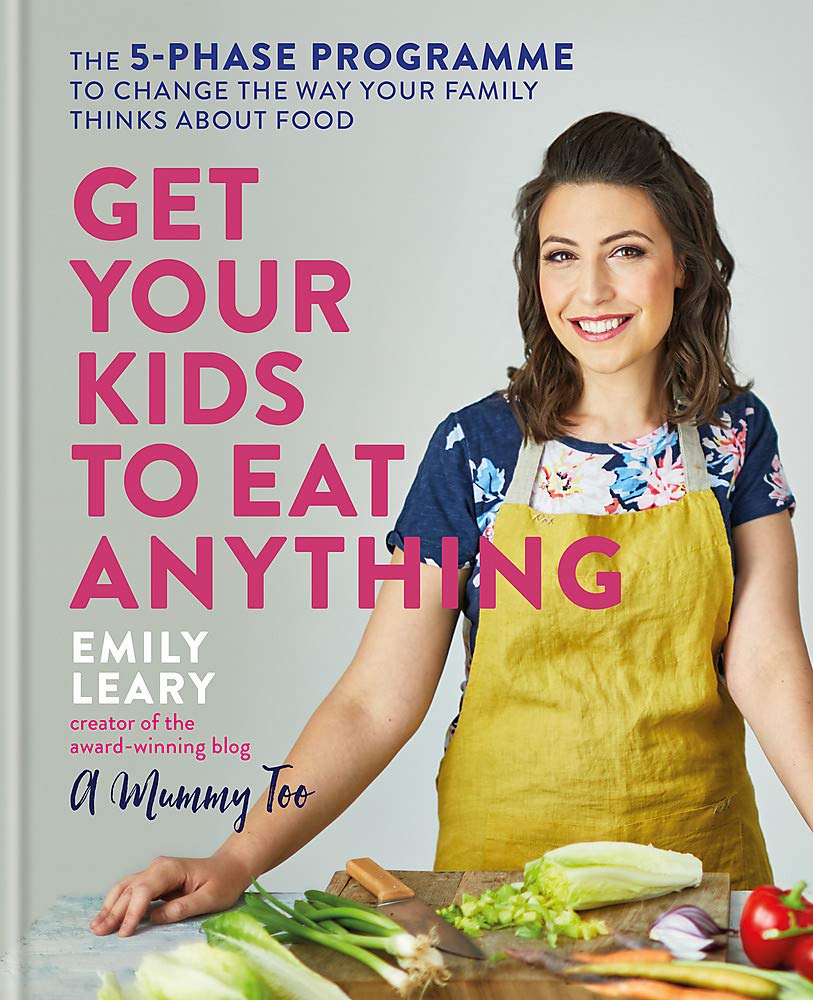
'This is a great kids cookery book. Emily is a star' - Simon Rimmer
'The book I'd like to force into any mother's kitchen' - Prue Leith
"A fab book with a plan." - Jane Devonshire, 2016 Masterchef UK winner
'Emily has managed to combine her mummy knowledge and passion for food to make a truly helpful and brilliant cookbook' - Priya Tew, RD, BSc (Hons), Msc
Get Your Kids to Eat Anything is an achievable 'how to' for parents in the battle to overcome picky eating and 'make new the norm'. Emily Leary's unique 5-phase programme looks at the issue of 'fussy eating' in a holistic way that links imagination with food, and which situates parents alongside - not in opposition to - their children.

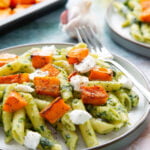
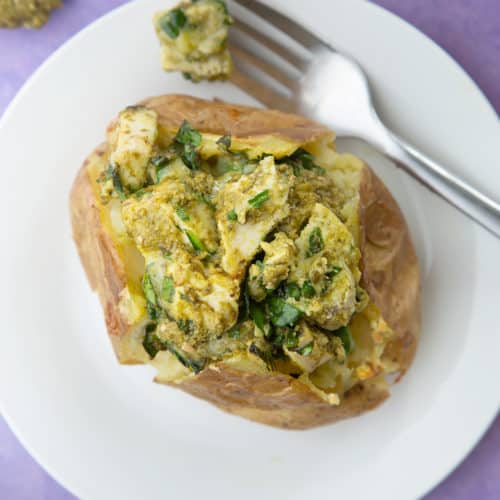
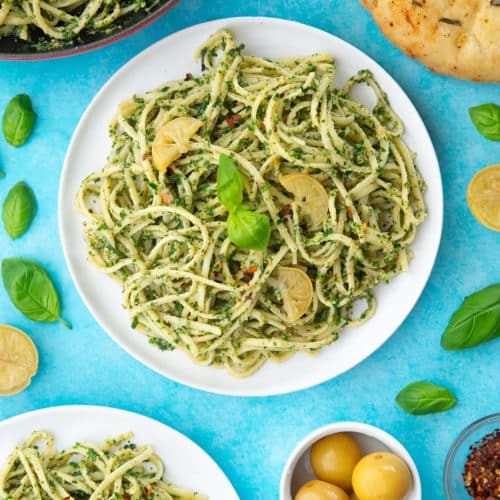
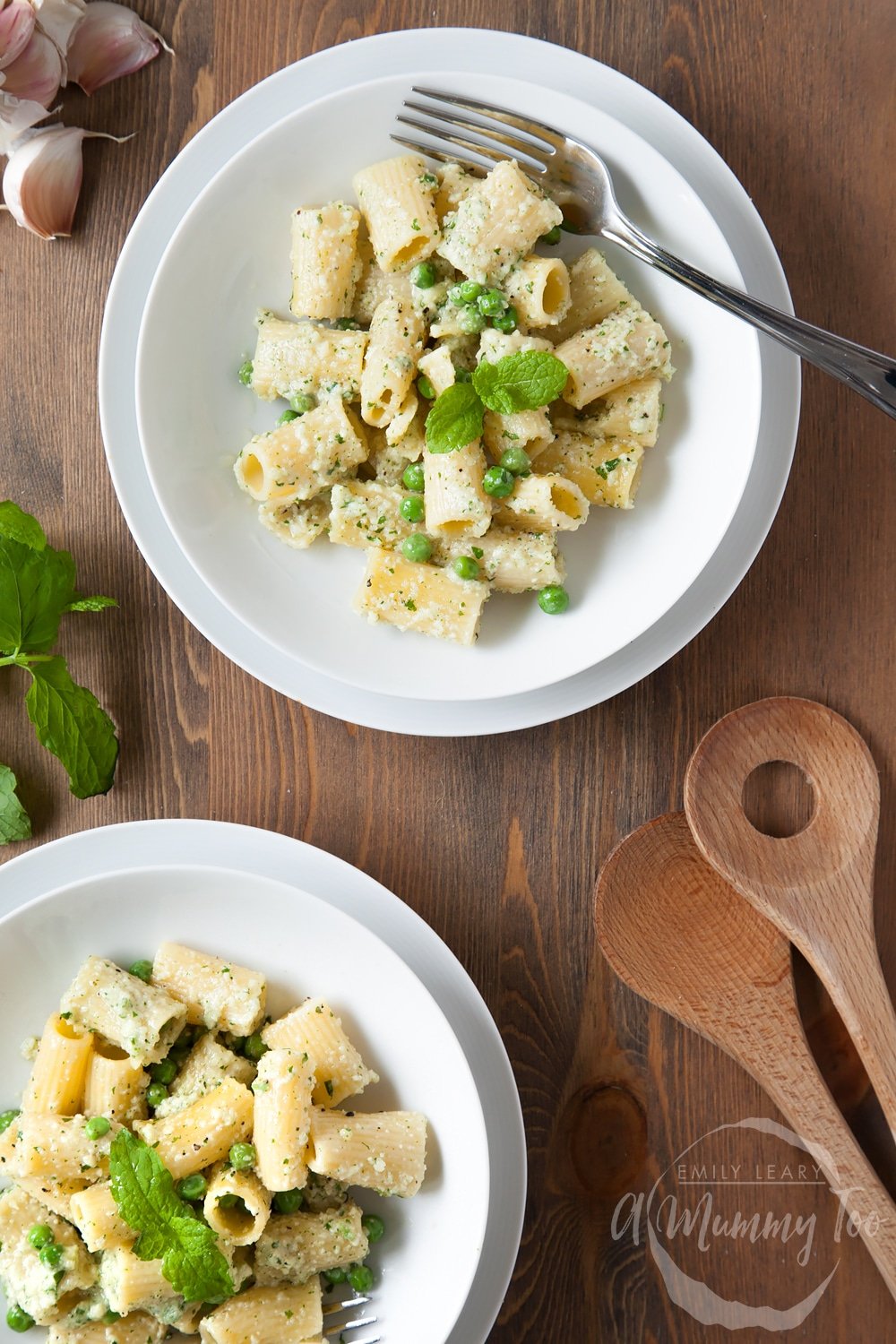
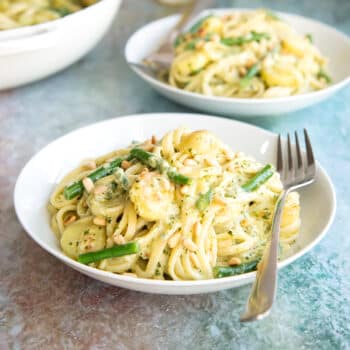
Leave a Reply